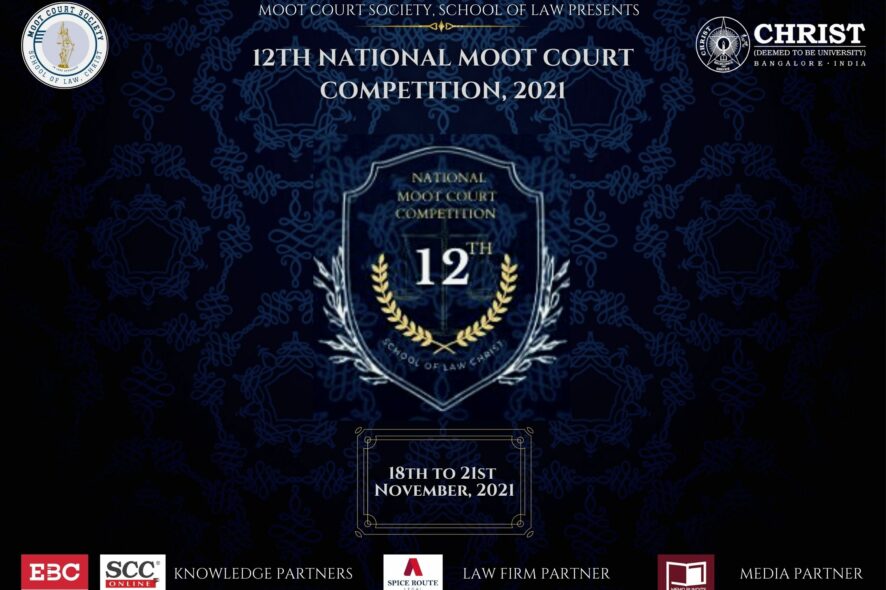Welcome to the 12th National Moot Court Competition organized by the Moot Court Society of School of Law, CHRIST (Deemed to be University), Bangalore!
Over the years, National Moot Court Competition (NMCC) hosted by School of Law, CHRIST (Deemed to be University) Bangalore has received great interest from students across the country and has evolved into one of the most sought-after Constitutional Law moots in the country. Continuing the tradition, the 12th Edition’s Moot proposition revolves around the contemporary constitutional questions regarding data protection and technology law, fair use of social media, and the right to free speech.
The Moot Court Society and the Organising Committee invite you to be a part of the 12th National Moot Court Competition and stay updated with all the events.
May the best team win.
The Researcher’s Test was conducted on 17th November, 2021 via Google Meet.
Tentative Schedule for Day 1: 18th November, 2021 Thursday
SCC Online Training Session -12:00 PM to 1:00 PM
Inauguration Ceremony – 4.30 PM to 5:30 PM
Judges Briefing – 5:30 PM to 6: 00 PM
Preliminary Rounds – 6:00 PM to 7:00 PM
Let Day 1 begin!
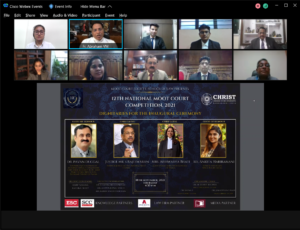
04:45 PM: The Inaugural Ceremony commences with the Lighting of the Lamp along with an inaugural song.
04:47 PM : Dr. Sapna S, Head of the Department, School of Law CHRIST( Deemed to be) University renders the Welcome address.
04:57 PM: Fr. Abraham VM, Vice Chancellor, CHRIST (Deemed to be University), Bangalore addresses the gathering by welcoming all the members present in the panel and wishes success to all the participants. In his address, he emphasized on the importance of Mooting culture in law school.
5:02 PM: The Chief Guest of the ceremony, Justice Mr. S Rajeswaran, Former Judge, Madras High Court, addresses the gathering. He congratulates the School of Law, CHRIST (Deemed to be University) for organizing the National Moot Court Competition. He further speaks about the different aspects of the Moot Proposition including Freedom of Speech and Expression and its relevance. 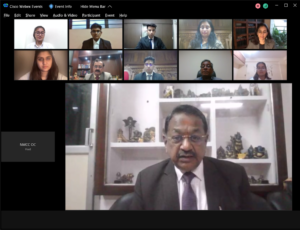
05:12 PM: The Chief Guest of the ceremony, Advocate Aishwarya Bhati, Additional Solicitor General of India, addresses the gathering. She talks about the importance of the IT Rules and the need for Regulation, a fundamental part of rule of law. She concludes her address by wishing the best for all the participants.
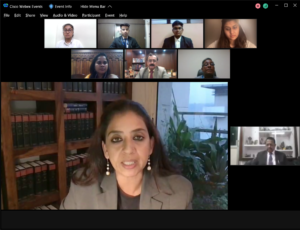
05:22 PM: The Guest of Honor, Adv. Pavan Duggal addresses the gathering. He emphasizes on the importance of robust Cyber Law in the wake of the increasing number of cyber crimes during Covid-19 Pandemic. He further enlightens the gathering by giving them a fresh perspective on Cyber Security and Data Protection law.
05:34 PM: The Guest of Honor, Ms. Ankita Hariramani- Senior Associate, Spice Route Legal addresses the gathering.
05:38 PM: Dr. Jayadevan S Nair, Dean, School of law, Christ ( Deemed to be) University, declares the 12th National Moot Court Competition open.
05: 40 PM: Mr. Harit Narang, Convener, Moot Court Society, School of law, Christ (Deemed to be) University, renders the vote of thanks.
05:42 PM: The Inauguration ceremony has come to an end.
The Preliminary Rounds will begin shortly.
Court Hall 1:
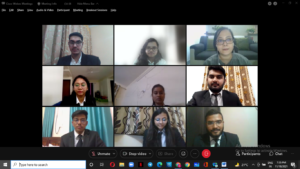
6:11 PM: With the permission of both the judges, speaker 1 for the petitioner has started mentioning the facts of the case.
6:12 PM: Speaker 1 confidently starts presenting his arguments on Issue 1 of the case.
6:21 PM: With no questions asked by any of the judges, Speaker 1 now moves on to presenting his arguments pertaining to Issue 2.
6:28 PM: With no questions asked by any of the judges, Speaker 2 of the petitioner’s side begins presenting his arguments.
6:40 PM: Petitioner speaker 2 is done with his arguments and since neither of the judges objected nor raised any issues the counsel is reciting prayers.
6:42 PM: Petitioner side, speaker 2 is now done with his prayers and now the judges request the first speaker from the Respondent’s side to move towards presenting her arguments.
6:44 PM: Respondent Speaker 2 starts presenting her arguments regarding the 1st Issue after seeking permission from the judges to address them collectively as your ladyship which nobody objects to at all. Respondent Speaker 2 now moves to the 2nd Issue of the case and presents her arguments regarding the same.
6: 44 PM: Respondent Speaker 2 now moves to the 2nd Issue of the case and presents her arguments regarding the same.
7:05 PM: Respondent Speaker 2 is done with presenting her arguments on the 3rd Issue and with the permission of the judges, she now moves to present her arguments on the 4th issue of the case.
7:09 PM: Now, since the respondents are done with their arguments, with the permission of the judges, the 2nd speaker moves towards the prayer.
7:11 PM: Now both the teams representing both the sides of the case move towards the rebuttals. The first speaker from the petitioner’s side moves on to question the respondents and also justify their own side of the case.
7:14 PM: After the petitioner’s side is done with their rebuttals, Speaker 1 of the respondent party moves on to their sur-rebuttal after seeking permission from the judges.
7:16 PM: Speaker 1 is done with her rebuttal and the 2nd speaker of the responding party now moves on to her sur-rebuttal.
7:20 PM: Since both the parties are done with their arguments, court is adjourned.
Court Hall 2:
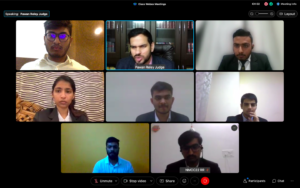
6:11 PM: Rounds started and the judge asked the counsel for the Petitioner to state the facts in their words and the petitioner obliged.
6:13 PM: The judge is questioning the counsel on why this issue was brought to Court in the first place. Judge is requesting the counsel to narrate the events and to name who approached the Court first.
The counsel pleaded for ignorance.
6:18 PM: The judge said the issues are not good enough and it is not an issue to take to court.
6:22 PM: The counsel is pleading for ignorance for all the questions asked by the judge and the Judge asked them to move on if the counsel is not ready to answer.
6:26 PM: Petitioner Speaker 2 started arguments.
6:28 PM: Judge questioned as to what is the exact rule violating fundamental rights.
6:38 PM: Petitioner Speaker 2 started his arguments again and the judge asked to move on.
6:42 PM: Petitioners ended their arguments and moved to prayer.
6:43 PM: Respondent Speaker 1 started with the arguments.
7:12 PM: The judge questioned the political rights and the copyright act.
7:13 PM: Respondent Speaker 2 answered that question in a unique answer of copyright infringement.
7:15 PM: The judge questioned the content takedown powers that may make the platforms lose their intermediary status as they would have substantial control over the content circulated over the platform.
7:19 PM: The judge questions regarding the content takedown powers that may make the platforms lose their intermediary status as they would have substantial control over the content circulated over the platform.
7:21 PM: The respondent answers by pointing out that the intermediary is only provided powers only when there is an authoritative notice by the State authorities, asking for the takedown, else, the platform’s community guidelines already takedown content when substantial reporting is done by the users.
7:27 PM: Court is adjourned.
Court Hall 3:
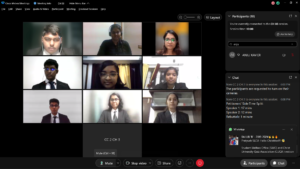
6:11 PM: With the permission of the judges, Speaker 1 for the petitioner has started mentioning the facts of the case.
6:18 PM: The Petitioner Speaker 1 has cited the case of Rammanohar Lohia.
Sakal Paper ltd. case . and Khusbu v. Kanimal to substantiate the arguments for issue 1.
6:20 PM: The judge has questioned the grounds upon which the court has been approached by the petitioners and if the restrictions on the Right to freedom of speech is absolute? And the Petitioner Speaker 1 has been substantiating her answer.
6:29 PM: The petitioner speaker 1 is concluding her arguments for issue 2 with an extension of 1 minute granted to her by the bench
6:30 PM: Counsel number 2 for the petitioner has started her arguments for Issues 3 and 4.
6:32 PM: Petitioner Speaker 2 has cited the Shreya Singhal v. Union of India to substantiate her arguments regarding the respondents’ violation of Article 19(2).
6:33 PM: Petitioner Speaker 2 cites the KS Puttaswamy judgment to substantiate her argument that Right to Privacy is an extension of the Right to Life guaranteed under Art. 21 of the Constitution of Nanda.
6:34 PM: Petitioner Speaker 2 cites Maneka Gandhi v. Union of India to substantiate her argument regarding arbitrariness.
6:36 PM: Judge has asked the Petitioner Speaker 2 to explain the application of the test of Proportionality under the Puttaswamy case; the speaker tries to answer substantially.
6:50 PM: The judge questions regarding the point of Copyright infringement as asserted by the RS 2 during her arguments for Issue 2.
6:55 PM: The Respondent Speaker 2 uses the argument of creativity and presentation of the idea and the argument that the author’s moral rights have been violated, thus substantiating the respondent’s stand
7:00 PM: The judge also questions the Respondents regarding the content takedown powers that may make the platforms lose their intermediary status as they would have substantial control over the content circulated over the platform.
7:07 PM: The respondents point out that the intermediary is only provided powers only when there is an authoritative notice by the State authorities, asking for the taken down, else, the platform’s community guidelines already taken down content when substantial reporting is done by the users.
7:15 PM: Petitioners’ rebuttal regarding vagueness of the arguments presented in the respondents’ memorial regarding the provision under which the Respondents assert infringement of the copyright.
7:20 PM: Court is adjourned
Court Hall 4:
6:13 PM: With the permission of the judges, Speaker 1 for the petitioner has started.
6:23 PM: Petitioner Speaker 2 started with arguments.
6:25 PM: Judge questioned Petitioner Speaker 2 about the grounds mentioned under Section 69 of IT Act.
6:30 PM: Petitioner Speaker 2 started with arguments for second issue
6:32 PM: Petitioner Speaker 2 neither summarized the arguments nor answered the question raised by the judge.
6:33 PM: Petitioner Speaker 1 started with arguments for the third issue from the beginning .
6:42 PM: Respondent Speaker 1 moves before the bench and starts laying down her arguments regarding issue no. 1 before the judges.
6:44 PM: Respondent Speaker 1 continues the arguments for issue no. 2 before the judges
6:59 PM: Respondent Speaker 1 has Summarized the arguments for the respective issues.
7:05 PM: Respondent Speaker 2 moved to arguments for issue 3
7:10 PM: Judge has questioned Respondent Speaker 2 and it was answered confidently by the speaker.
7:12 PM: Respondents seek permission for Prayer
7:15 PM: Respondents addresses the question raised by the petitioner during the rebuttal round.
7: 20 PM: Court Session Adjourned.
Court Hall 5:
6:04 PM: Both the teams have joined.
6:14 PM: Both the judges have joined the meet.
6:15 PM: Petitioner Speaker 1 has started speaking with the permission of the judges and has proceeded to state the facts of the case.
6:27 PM: The judge questions petitioner speaker 1 and petitioner speaker 1 diligently answers the judges’ question by citing Shreya Singhal v. UoI. and Kesavananda Bharati vs State of Kerala.
6:42 PM: Petitioner Speaker 2 starts speaking with the judge’s permission and is mentions the articles in the constitution about the laws related to the case.
6:44 PM: Judge 1 asks the Petitioner Speaker 2 to read a paragraph from the proposition and asks Petitioner Speaker 2 to tell him the basis of the claim made in her speech.
6:53 PM: The judge asks petitioner Speaker 2 to mention the point of law in her statement.
7:00 PM: The petitioner’s side proceeds with the prayer.
7:05 PM: The Judge questions Respondent Speaker 2 on Public Accountability and Right to Information Act, 2008.
7: 19 PM: Respondent Speaker 1 is concludes his speech and Respondent Speaker 2 begins his speech with the Judges permission
7:27 PM: The judge asks Respondent Speaker 2 about the relevance of his arguments in reference to the issue and what the violation of public order is as a follow up question.
7:38 PM: Respondent Speaker 2 submits his prayer to the bench.
7:43 PM: The rebuttals and sur-rebuttal commence.
7:53 PM: The rounds come to an end. The court is adjourned.
Court Hall 6:
6:11 PM: The judges and the participants have joined the Court Hall.
6: 15 PM: Petitioner Speaker 1 approaches the bench and seeks permission to proceed with the issues.
6:27 PM: Petitioner Speaker 2 approaches the bench and seeks permission to proceed with the issues.
6:43 PM: Respondent Speaker 1 approaches the bench and seeks permission to proceed with the issues.
6:50 PM: Judges ask the respondent speaker 1 to be more precise and clear in their arguments. He further questions the speaker regarding defamation and sedation.
6:58 PM: The Respondent Speaker 2 proceeds with the issues.
7:13 PM: The Rebuttals have begun and the Petitioner speaker 1 has put forth his contentions.
7:15 PM: Judges raise further concerns on the arguments raised by the petitioners. The petitioners respond to the questions of both the judges.
7:20 PM: Respondent Speaker 2 starts the sur-rebuttal.
7:25 PM: The rounds come to an end. The court is adjourned.
Court Hall 7:
6:05 PM: Both teams and judges have joined the breakout room.
6:16 PM: The other judge has also joined the meet.
6:21 PM: Petitioner speaker 1 has started with issue 1 and related it to Freedom of Privacy
6:24 PM: Petitioner speaker 1 has started with issue 2
6:29 PM: Judge 1 questions Petitioner speaker 1,Petitioner Speaker 1 responds confidently and proceeds with the issue.
6:36 PM: Petitioner speaker 2 started with Issue b.
6:38 PM: The judge asks petitioner speaker 2 a question related to fair deal, to which the Petitioner speaker 2 responds unsatisfactorily.
6:43 PM: The judge asks the petitioner speaker 2 about fair dealing to which the Petitioner Speaker 2 responds sufficiently.
6:50 PM: Judge asks petitioner speaker 2 about the validity of right to privacy, stating that there should be some restrictions to privacy.
6:55 PM: The judge questions petitioner speaker 2 on the restrictions that were mentioned, stating that there was no violation of Article 21.
6:58 PM: The petitioner Speaker 2 submits the prayer to the bench.
7:09 PM: The judge asks a question about emojis and asks if they have any case laws to substantiate their point. Respondent Speaker 2 answers the question satisfactorily
7:13 PM: The judge asks a question about governments’ misuse of defense of public order. Respondent Speaker 1 stated that it is a reasonable restriction.
7:18 PM: The Judge questions the speaker about the Central Government’s power to block content.
7:22 PM: The respondent speaker cites the example of Donald Trump’s video relating to copyright.
7:26 PM: The judge asks the counsel to elaborate more on the copyright issue.
7:37 PM: The Respondent speaker talks about the involuntary elimination and further cites the Puttaswamy Judgment.
7:47 PM: The Counsel submits the prayer.
7:49 PM: The petitioners start the rebuttal.
7:53 PM: The rounds have come to an end.
8:28 PM: The Court is adjourned.
Court Hall 8:
5:57 PM: Both teams have joined the breakout room and are waiting for the judges to join.
6:05 PM: Both the teams introduced their respective sides
6:11 PM: Speaker 1 from the petitioner’s side has asked for permission to approach the bench and has begun with the facts of the case.
6:15 PM: The judge questioned the counsel on the jurisdiction of the District Court.(Art. 226 of the Constitution of Nanda)
6:17 PM: The judge is questioning the counsel on why this issue was brought to Court in the first place. Judge is requesting the counsel to narrate the events and to name who approached the Court first.
6:20 PM: Counsel 1 is elaborating on the importance of the fundamental right of speech and expression. The judge is questioning the counsel on the arguments advanced in memorial of the petitioner.
6:22 PM: The judge is questioning the counsel on the arguments advanced in memorial of the petitioner
6:25 PM: The judges question the extent and scope of Article 19 of the Constitution.
6:28 PM: The judge points out discrepancies in the memorial from the petitioner’s side. These refer to the violation of fair use policy.
6:29 PM: The judge highlights the case of EBC v. D.B. Modak to define copyright infringement. He further asks the counsel to back his arguments with statutes. The Counsel begs to differ.
6:41 PM: Counsel 2 from petitioners side seeks permission to approach the bench and deal with the further 2 issues.
6:44 PM: The judge questions how the violation of Article 14 has taken place and the Counsel has answered accordingly.
6:45 PM: Judge reads out Article 14 of the Constitution and questions whether a company falls within the ambit of a “person”. The counsel responds by stating that a company falls under a “legal person”.
6:48 PM: Self-regulation and its need is discussed by Counsel 2.
6:50 PM: The judges have placed the question of maintaining public order and the extent to which individuals can post on social media platforms.
6:54 PM: The judge points out the double standards between EU and Asian regulations.
6:59 PM: The petitioner submits his prayer to the bench. The judges point out fallacies in the prayer from the petitioner’s side.
7:05 PM: The Counsel 1 from respondents summarizes the facts of the case in 5 sentences and continues with the first issue.
7:10 PM: The Counsel 1 submits his arguments on issue 1,i.e blocking Indu’s access and discusses why the fundamental rights are not violated in this case.
7:15 PM: The judge questions the respondents why they have approached the High Court. The Counsel 1 has answered accordingly.
7:25 PM: Counsel 1 concludes his arguments and counsel 2 seeks permission to approach the bench and begin with the last 2 issues.
7:28 PM: The Counsel has explained the definition of the word “news” on the request of the judges.
7:35 PM: The judge states that for the working of a healthy democracy there should be the presence of freedom of expression while enabling individuals to make informed decisions. The Counsel responds accordingly by drawing examples.
7:40 PM: Counsel 2 proceeds with issue 3 by discussing the case of Shreya Singhal.
7:49 PM: The counsel argues that there is no violation of fundamental rights and explains the test of reasonability. He further explains what “due diligence” means.
7:53 PM: The Counsel discusses the IT rules and when they can be invoked. He further explains why Article 21 has not been violated. The judges question him on the competence of the authorities in this case.
7:59 PM: The respondents seek permission to humbly submit their prayer and submit their prayer to the bench.
The Court Hall is adjourned.
Court Hall 9:
6:08 PM: After counsel 1for the petitioner asked permission to approach the bench, judge 1 has asked the counsel for the petitioner(1) to state the facts in their words and the petitioner has obliged.
6:12 PM: Counsel for the petitioner has proceeded with the statement of jurisdiction with the judges’ permission.
Judges have discussed and intimated to skip court etiquettes, even addressing “lordship”, and focus on arguments.
6:16 PM: Counsel 1 for the petitioner started their argument.
Judge 1 asks counsel 1 for the petitioner to quote citation along with judgements.
Judge 2 has questioned counsel 1 for the petitioner on their argument.
6:20 PM: Judge 1 has asked counsel 1 for the petitioner to stick to the preliminary argument. He, along with judge 2, has asked to address whether section 69(A) of the IT Act is constitutional or not.
6:24 PM: Counsel 1 for the petitioner requests to proceed with issue 2. Judge 1 is confirming their argument with a summary.
6:27 PM: Judge quotes para 8 of the proposition and asks whether the parliament is completely composed of the government in power. He is proceeding to ask two questions.
6:33 PM: Judge 2 asks the second counsel for the petitioner to start their arguments since the time allotted to counsel 1 for the petitioner has elapsed.
6:34 PM: Counsel 1 for the petitioner asks for 30 seconds. The judges allow with a caveat. Counsel 1 for the petitioner is answering. Counsel 2 for the petitioner started their arguments.
6:37 PM: Judge 2 asks the tests to strike down a legislation passed by the parliament. Counsel 2 for the petitioner is answering with two points and a case law example.
6:46 PM: Judge has granted extra time for mentioning citation. Counsel 2 for the petitioner is asking permission to state their prayer. The judges have allowed it. Counsel 2 for the petitioner has proceeded accordingly.
6:50 PM: Counsel 1 for the respondent is confirming the pattern of proceedings, i.e., whether to stick to formalities or not. The judges have asked to skip formalities. Counsel 1 for the respondent has started their arguments. Judge 2 has asked a question and counsel 1 for the respondent is answering politely.
6:57 PM: Judge 1 and the counsel 1 for the respondent discuss what better way could there be than protest. Counsel 1 for the respondent continues to answer in accordance with the proposition. Judge 2 is asking whether there was apprehension; Counsel 1 for the respondent is answering that the proposition is silent on it.
7:01 PM: Counsel 1 for the respondent is asking permission to proceed with her argument and the judges have allowed it. Judge 2 questions what other efforts were made other than the tweet. Judge 2 is asking counsel 1 for the respondent to read a part of the proposition and is questioning them on it.
7:14 PM: Counsel 1 for the respondent asked if they could sum up. Judges deny due to the paucity of time and assure that the counsel did well. Counsel 2 for the respondent has begun their argument after confirming about the formalities.
7:17 PM: Counsel 2 for the respondent explains how the petitioners misinterpreted a certain section.
7:21 PM: Counsel 2 for the respondent is asking permission to move to the third issue. The judges have allowed it. Judge 1 appreciates the respondent’s argument and questions the extension of laws to govern the common people as hosts of information. Judge 1 also asks how that works when the argument of respondents is that social media is unnecessarily being brought in.
7:37 PM: Judge 1 proceeds to explain a similar case in real life and its significance today. Judge 1 emphasizes that while arguing, one must keep in mind that justice might be delayed, but will not be denied. Judge 1 is elaborating that judges and lawyers are attempting to ensure that justice is not buried. Judge 1 is proceeding to appreciate counsel 1 for the respondent for presenting skillfully.
7:43 PM: Court Hall adjourned.
Court Hall 10:
6:09 PM: With the permission of the judges, speaker 1 for the petitioner has started mentioning the facts of the case.
6:14 PM: Judge poses a question whether there are any explicit provisions under any law which bars people from using a certain platform.
Speaker 1 contends that there is no such provision.
6:20 PM: Speaker 1 states that citizens’ rights mustn’t be infringed upon. Judge poses a rhetorical question that it wouldn’t be unlawful to block a person. Speaker tries to justify her argument through the perspective of the rights being talked about here, which are fundamental.
6:25 PM: Freedom of press hasn’t been used in article 19(1)(a), but constitutes the heart and soul of freedom of expression. Judge states that public order is at stake. Counsel states that the term in itself is vague.
Judge contends that it depends on the facts and circumstances of each case.
Speaker uses the same point to justify her argument. Speaker 1 has completed her submission. Judges have no further questions.
6:30 PM: Counsel states that the end-to-end encryption would be at stake if the government enforces the same. Judge states that there are judgments wherein it was held that a particular information cannot be hosted without their permission. The Judge counter questions as to whether there must be any regulation on the same. Counsel contends that the same mustn’t be at the cost of fundamental rights.
Speaker states that ambiguous terms were used, thereby, leaving scope for misuse.
6:35 PM: Judge questions that the ambit of “news aggregator” under the IT act is also wide and that foreign contributions were made, thereby violating FCRA rules. Counsel states that it was dependent on people and not the government.
6:40 PM:. Respondent Speaker 1 speaker takes the requisite permissions and proceeds to the arguments. Speaker 1 contends that the Internet provides a large scope of misuse, and thereby provides scope for higher crimes like hacking, harassment, cyber phishing, etc. Counsel states that Objectionable messages are hard to contain when such a perspective comes into question. Counsel cites Article 19(3) of the ICCPR provides certain restrictions. Counsel reads out a tweet which provides knife emojis.
6:45 PM: Counsel contends that Indu’s intention was a lawless action, with certain hate towards a party, thereby, it can be criminalized. Art 19(2) provides certain limits to allow for Freedom of speech and expression to be practiced.
6:50 PM: Judge questions that the act of not giving information by itself is violative of the provisions of the IT Act. Counsel states that the government provided information on the same and only curbed messages which were harmful to the sovereignty and integrity of India.
7:00 PM: Counsel cites 66A of the IT Act along with Art 19(1) and provided reasons for the importance of regulation of hate speech. Counsel submits that the actions of Indu are anti-national and that they’re violative of the laws of the country. Counsel moves onto Issue 2 with requisite permissions. Counsel states that Dhriti was not in her power to approach Seiji, or didn’t have the authority to question. Counsel concludes his argument.
7:10 PM: Counsel rests her argument. Counsel for the petitioner cites Para 5 of the Proposition in her rebuttal by stating that Indu faced no injury. Counsel also stated in the rebuttal that merely opinionating a point of view does not count as a “false statement” merely because it is opposing the government. Counsel fact checks certain statements said in the respondents’ arguments.
7:20 PM: Court Hall adjourned.
Court Hall 11:
6:26 PM: Petitioner Speaker 1 argues Issue 1 – Indu has not violated Article 19(1)(a).
6:27 PM: Quoted Maneka Gandhi v. Union of India to cite the importance of Freedom of Speech and Expression. Transparency of the Government is essential.
6:29 PM: Petitioner questioned about the restriction regarding the sovereignty and integrity of the country. Petitioner replies by stating that Indu has not violated the same as she only expressed her opinion and exercised her right to be vocal.
6:31 PM: Petitioner argues Issue 3 by stating that The IT Rules of 2021 are violative of the Constitutional provisions. No statute in place that allows for the infringement of privacy. Rule 3 is very vague in nature – what is ‘unlawful content’? – against the principles of natural justice due to the limited time of 72 hours within which the content must be removed. Article 14 of the Constitution was also violated.
6:36 PM: Petitioner questioned about the criterion of natural justice under which it can be rendered null by the Court. Petitioner pleads ignorance.
6:44 PM: Speaker cites Blackwood & Sons Ltd. V. A.N. Parasuraman to show the importance of copyright and lack of intention to defame.
6:51 PM: Issuance of notice should be removed by Govt. of Nanda followed by Prayer by the petitioners – allow access to accounts, dismiss orders passed by District Court as no violation of copyright rules , declare IT Rules are unconstitutional, allow foreign funds.
6:59 PM: Judge questions the Counsel about the contradiction in her speech about reasonableness of restrictions. Counsel refers to the test of reasonableness to clarify herself.
7:09 PM: Counsel concludes and Respondent 2 begins.
7:11 PM: Issue 3 argued. KS Puttaswamy 2017 case cited to state that right to privacy is not absolute. PUCL v. UOI also cited and Proportionality test discussed.
7:16 PM: Counsel questioned about the justification given earlier. Counsel makes reference to the proposition and cases mentioned earlier.
7:20 PM: Issue 4 argued.
7:24 PM: Counsel submits prayer.
7:27 PM: Court Hall Adjourned.
Court Hall 12:
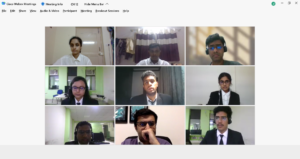
6:09 PM: Speaker 1 is speaking about the issue 1 with the permission of judges.
6:12 PM: Judge 2 is speaking about the reasonable restriction and questioning the Speaker 1 regarding the same. Judge 2 is questioning the criticism and blocking of the content.
Speaker 1 is not able to answer the question of Judge 2.
6:17 PM: Speaker 1 has started speaking about issue 3 and has cited the case, K Puttaswamy V Union of India.
6:20 PM: Proportionality test aspects are being discussed by the Speaker 1 and Judge 2 questioned the proportionality test and also asked questions related to the same. Speaker 2 started speaking of issue 2 and cited the Union of India vs Jindal.
6:26 PM: Speaker 2 is speaking about the video being shared and the judge 2 is questioning how they will be protected under the Copyrights Act. Four factors of the copyright are being spoken by Speaker 2.
6:32 PM: Speaker 2 started the 4th issue. Speaker 2 is speaking about the press notes and the IT Act 2021.Speaker 2 is speaking about the foreign funds and FDI aspects. Judge 2 is questioning the restrictions and the importance of control. Speaker 2 agreed with Judge 2 thought on the funds being utilization and control. Speaker 2 finished his part of the arguments and concluded.
6:40 PM: Speaker 1 started the 1 issue of the case. The speaker further stated that the blocking of Indus is valid under law and there is no violation of freedom of speech and expression. Judge 2 is questioning about the dissent and the aspects of the curtailment of the freedom of speech and expression of Dhriti right.
6:52 PM: Speaker 2 started speaking about issue 2. The counsel is speaking about the copyright act. The speaker 1 is speaking about the Drithi video and the research paper used by Drithi. Judge 2 is questioning the copyright act being used from Drithi.
7:08 PM: Speaker 2 finished the prayer.
7:09 PM: Petitioner speaker is contending the Digi-cable case used by the respondents. Petitioner further stated that the Subramanian Swamy case is a criminal case and does not come under the ambit of the present case.
7:11 PM: Court Hall adjourned.
Court Hall 13:
6:00 PM: Both teams have joined the meeting and are waiting for judges.
6:08 PM: Judges have joined. CC 1 is briefing them about the rounds.
6:10 PM: The petitioners have started their arguments.
6:11 PM: The judge asked speaker 1 to start by briefing the facts. Speaker 1 has started with the facts.
6:12 PM : Speaker 1 is proceeding with Issue 1 and 2.
6:15 PM : Speaker 1 is talking about freedom of speech and expression.
6:17 PM: Speaker 1 is talking about registered political parties and 19(1)(a) and the right to know about the affairs of political parties.
6:19 PM: Right to dissent is an inherent part of democracy. Speaker cites ADM Jabalpur V. SK Shukla and AK Gopalan V. State of Madras.
6:20 PM: Speaker 1 proceeded with the 2nd issue after judges had no questions. He starts by explaining Fair use and Copyright.
6:25 PM: Speaker 1 is explaining how the case laws stated are relevant in this case.
6: 25 PM: Speaker 1 has completed his submission. Judges have no further questions.
6:25 PM: Speaker 2 proceeds with issue 3 and 4. The submission of the 3rd issue in 3 folds by the speaker. Speaker 2 is talking about end-to-end encryption and traceability.
6:26 PM: Judge asked 2 questions to the speaker 2.How do they violate the constitution and need for reasonable restriction on fundamental rights. Speaker 2 is answering the judge.
6:26PM: Judge asked the speaker to make a distinction between privacy and anonymity. Speaker 2 could not answer.
6:42 PM: Speaker 1 started with issue 1.Speaker 1 is talking about sedition and drawing parallels with the proposition. Speaker 1 is presenting case laws.
6:45 PM: Judge asked the speaker to correlate arguments on how they are violative of fundamental rights and case law. The other judge asked how describing someone using emojis is inappropriate.
6:48 PM: Speaker 1 is explaining what constitutes sedition. Judge asked what is the balance between defamation and sedition.
6:49 PM: Judge asked what are the ingredients of sedition and which section deals with sedition.
Speaker 1 proceeded to issue 2 after judges had no questions. Speaker 2 proceeds with issue 3 and 4 after speaker 1 presents their arguments.
6:52 PM: Judge asks what were the crimes the government was trying to curtail. Judge questioned the speaker about reasonable restrictions and hampering the right to freedom of speech and expression. The other judge asked if there is a due process established by law?
Speaker moved on to issue 4.
7:03 PM: Judge questioned the counsel and they are answering the question.
7:15 PM: Brief rebuttal from the petitioner. Sur-rebuttal from the respondent.
7:21 PM: The Petitioners have 5 rebuttals for the Respondents
The Respondents begin with their sur-rebuttal.
7:30 PM: The rounds come to an end, and the Court is adjourned.
Court Hall 14: – Not Functioning
Court Hall 15:
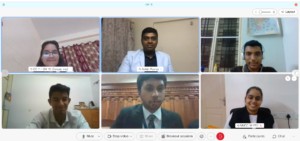
6:03 PM: Both sets of participants have joined the meeting
6:07 PM: Both the judges have joined the meeting
6:09 PM: The facts of the case are being summarized by Petitioner Speaker 1
6:11PM: The arguments regarding Issue 1 are being laid out by Petitioner Speaker 1
6:18 PM: The Petitioner Speaker 1 is arguing on Issue 4
6:22PM: The Petitioner Speaker 2 has begun the arguments regarding Issue 2 and 3
6:24 PM: Teams are waiting for the second judge to join the session, the time for Petitioner Speaker 2 have been paused
6:28PM: The second judge has joined the meeting, Petitioner Speaker 2 has resumed her arguments
6:29 PM: The Petitioner Speaker 2 and the Judge discuss the Puttaswamy judgement with reference to the issues at hand
6:34 PM: The Petitioner Speaker 2 proceeds with the prayer.
6:43PM: The facts of the case are being summarized by Respondent Speaker 1
6:46PM: The arguments regarding Issue 1 are being laid out by Respondent Speaker 1.
6:51 PM: The judges question Respondent Speaker 1 as to how the Courts of Nanda view precedents
6:53 PM: The Respondent Speaker 1 proceeds to Issue 2
6:56 PM: The judge questions as to whether the video created by Dhriti Tiwari is an adaptation or a reproduction under the Copyright laws.
6:58 PM: The Respondent Speaker 2 begins to argue Issues 3 and 4
7:02 PM: The judge questions the relevance of the FN Balsara case in the present case
7:07 PM: The judge asks for the facts of the Shreya Singhal case
7:09 PM: The Respondent Speaker 2 moves on to Issue 4.
7;15 PM: The Respondent Speaker 2 proceeds to prayer. The Petitioners have 5 rebuttals for the Respondents
7:21 PM: The Respondents begin with their sur-rebuttal.
7:30 PM: The Rounds come to an end and the Court is adjourned.
Court Hall 16:
6:49 PM: Rounds have commenced.
6:50 PM: Petitioner Speaker 1 has started arguments
6:54 PM: The judge questioned Petitioner Speaker 1 on the writ he was seeking. Petitioner Speaker 1 pleaded ignorance
6:59 PM: Petitioner Speaker 1 goes on to address Issues raised.
7:07 PM: Petitioner Speaker1 time is up. Judge extends time given to the speaker.
7:12 PM: Speaker 2 has approached the bench and has begun addressing the issues of the case The judge questions in regards to the binding nature of Shreya Singhal vs Union of India.
7:17 PM: The Judges question the speaker on the applicability of Right to Privacy in this case. The Judges question the speaker on the applicability of Right to Privacy in this case. Petition Speaker 2 has proceeded to the prayer
7:21 PM: Respondent Speaker 1 has approached the bench. Speaker 1 has begun stating the facts from the respondents point of view.
7:36 PM: The speaker has begun addressing the issues before the court.
7:40 PM: The Judge questioned Respondent Speaker 1 on the blocking of content under Section 69. The Judge questions on the applicability of Section 51 and 52 of the Copyright Act to the case.
7:55 PM: The Respondent Speaker’s speech has come to an end. RS2 has approached the bench and has begun his arguments.
8:15 PM: The judges questioned Respondent Speaker 2 regarding Special Leave Petitions.
Rebuttals have begun
8:22 PM: The session is adjourned.
Court Hall 17:
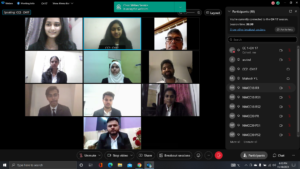
6:12 PM: Teams have joined and the round has begun.
6:16 PM: Petitioner Speaker 1 starts arguments for Issue no. 1
6:24 PM: After elaborating on the Freedom of Speech and Expression, the Counsel proceeds to issue no. 2.
6:27 PM: Speaker 2 started with the arguments for the next issue
6:29 PM: Petitioner Speaker 2 is speaking about fundamental rights infringed.
6:32 PM: Petitioner Speaker 2 is arguing about blocking of content violating rights under Section 69 of IT Act.
6:36 PM: Petitioner Speaker 2 moved on to the next issue regarding FDI policies and FCRI Rules Speaker 2 concluding Arguments
6:37PM: Respondent Speaker 1 starts with Issue 1 with respect to blocking of accounts and argues that it is not unlawful.
6:40 PM: Respondent Speaker 1 starts with Issue 1 with respect to blocking of accounts and argues that it is not unlawful.
6:47 PM: Respondent Speaker starts with the 3rd issue. Respondent Speaker 2 explains Rule 3 and 4 of the IT Intermediary Guidelines and argues that the restriction is reasonable. Respondent Speaker mentions the harmonious work of FEMA and FDU.
7:07 PM: Respondent Speaker 2 moved on to Issue 4 mentioning about harmonious work of FEMA and FDI and dangerous consequences if it does not happen.
07:08 PM: Petitioners started Rebuttal.
7:17 PM: Respondents begin with the Sur-rebuttal. Rounds completed.
7:30 PM: Court is adjourned.
With this, Day 1 comes to an end!
Let the Day 2 begin!
05:50 PM: The Judges Briefing Session is in progress.
The Preliminary Rounds will begin shortly.
Court Hall 1:
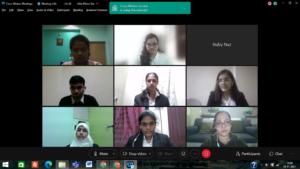
6:05 PM: The round has commenced. Petitioner Speaker 1 started speaking with the judge’s permission.
6:13 PM: Judge questions Petitioner Speaker 1.
6:15 PM: PS1 proceeds with arguments for the second issue.
6:20 PM: Petitioner Speaker 2 started with the arguments of issue 3.
6:22 PM: Petitioner Speaker 2 started with the arguments of issue 4.
6:32 PM: Petitioner Speaker 2 proceeds with the prayer.
6:33 PM: Despondent Speaker 2 proceeding with the prayer.
6:34 PM: Respondent Speaker 1 started with the issues arguments with the permission of the judges.
6: 40 PM: Respondent Speaker 1 started with the arguments of issue 2.
6:44 PM: Respondent Speaker 1 started with the arguments of issue 3.
6:49 PM: Respondent Speaker 2 started with the permission of the judge on issue 4.
6:55 PM: Respondent Speaker 2 proceeds with the prayer.
7:00 PM: Court is adjourned
Court Hall 2:
6:09 PM: With the permission of the judges, rounds have begun, Petitioner Speaker 1 has started speaking.
6:011 PM: Petitioner Speaker 1 has commenced the arguments for Issue 1.
6:13 PM: Judge poses questions regarding the contentions of the Petitioner, questioning the ambit of the rights that have been infringed.
6:15 PM: Judge asked Petitioner Speaker 1 to cite any case law after 2005 wrt RTI as a fundamental right and not a statutory right on the claim of the speaker. The Speaker pleads ignorance.
6:19 PM: Judge questions the jurisdiction of the HC through the RTI Act, Petitioner Speaker 1 has not answered the questions satisfactorily.
6:23 PM: Executive actions are arbitrary in nature; the judge asks for the definition of arbitrary and asks for a case law, Petitioner Speaker 1 does not have Indian case law, cites US Supreme Court Case (Donald Trump’s case). Judge asks the meaning of arbitrariness and the test of arbitrariness, Petitioner Speaker 1 does not have a satisfactory answer.
6:27 PM: Judge 2 asks Petitioner Speaker 1 to read out the memorial page 14, bringing out the inconsistency in the contentions of the petitioners.
6:29 PM: Petitioner Speaker 1 has commenced arguments for Issue 2. Petitioner Speaker 1 has elapsed all the 16 minutes, judges have granted an extra 5 minutes.
6: 39 PM: Petitioner Speaker 2 has commenced arguments for issue 3 with the permission of the court.
6:40 PM: Petitioner Speaker 2 cites State of Karnataka & Ors. v. Ganesh Kamath & Ors. to argue that the Rules are ultra vires the Parent Act, Judge 2 poses the question what the contentions of the petitioners are, how the Rules are ultra vires the constitution by being ultra vires the Parent Act. Judge asks PS1 to furnish the arguments in the memorial submission, PS2 pleads ignorance.
6:47 PM: Petitioner Speaker 2 says the Rules are violative of the principles of natural justice in the IT Rules are ignored.
6:51 PM: PS2 states that Rule 11-14 is violative of Art 14, as he claims that it is infringing upon rule of law. Judge asks the nexus behind Art 14 and the arguments of PS2.
6:53 PM: Judge asks that a mere notice has been issued, asking for 2 instances where the Court has struck down based on issue of a notice. PS2 pleads ignorance.
6:57 PM: Respondent Speaker 1 has commenced his arguments for Issue 1 with the permission of the court.
6:59 PM: Respondent Speaker 1 quotes IT Rules, 2009 with regards to blocking of information as an interim measure in the interest of the nation.
7:02 PM: Judge 2 calls notice of Para 5 line 3 of the facts to justify that the actions of the respondent were malafide; Para 9 to justify to state that the respondent is party to the government, questions the arbitrary nature of the respondent’s actions.
7:05 PM: Respondent Speaker 2 has not been able to answer the Judge’s line of questioning.
7:07 PM: Judge 2 states arguments of Respondent Speaker 1 are not convincing, Respondent Speaker 2 asked to move on.
7:11 PM: Respondent Speaker 2 cites “RD Shetty v. Union of India”, Ajay Hasia v. Khalid Mujib cases.
7:16 PM: Respondent Speaker 2 cites Chancellor Masters and Scholars of the University of Oxford v. Narendra Publishing House.
7:18 PM: Respondent Speaker 2 commences arguments for issue 4. Cites Tehseen S Poonawalla v. UoI.
7:20 PM: Judge 2 asks whether fundamental right to privacy, Art 21 extends to companies and corporations in India as well; Respondent Speaker 2 unable to answer the question of the judge satisfactorily.
7:22 PM: Judge asks for provisions for an opportunity to be heard after issuing notice, and directions for removal of content, Respondent Speaker 2 pleads ignorance.
7:24 PM: Judge questions the procedural reasonableness in Rule 3, 2, 7; asks Respondent Speaker 2 the meaning and distinction between procedural and substantive reasonableness under Art 19;
7:28 PM: Respondent Speaker 2 moves to the prayer.
7:29 PM: Judge 2 poses a question to Petitioners, Petitioner Speaker 1 has answered the question.
7:32 PM: Court is adjourned
Court Hall 3:

6:00 PM: The round has commenced. Petitioner Speaker 1 started speaking with the judge’s permission.
6:03 PM: Petitioner Speaker 1 is talking about issue 1 and 2.
6:14 PM: Petitioner Speaker 1 answered the questions and and completes his submission on issue 1 and 2.
6:15 PM: Petitioner Speaker 2 from the petitioner side started speaking on issue 3 and the judges questioned him but he was not able to answer properly. He continues with his argument.
6:30 PM: The speaker proceeds with the prayer with the judge’s permission.
6:31 PM: The respondent speaker 1 proceeds with issue 1 with the judge’s permission and will discuss issue 1 and 2
6:36 PM: The judge questions respondent speaker 1 on violation of doctrine of accountability
6:38 PM: The Respondent Speaker 1 answers the question and proceeds with issue 2 with the permission of the judges.
6: 44 PM: Respondent speaker 1 side completed his submission on issue 2
6: 55 PM: The judges question respondent speaker 2 on three fold test in the Puttaswamy v State of India case.
7:01 PM: The judges question Respondent speaker 2 and he answers the question and completes his arguments on issue 4.
7:06 PM: The respondent side requests the judges to allow the petitioners to repeat their question and the petitioner speaker 1 repeats
7: 07 PM: The respondent side speaker 1 starts with the sur-rebuttal
7:09 PM: The respondent side speaker 1 asked the judges if speaker 2 could continue with the other questions in the sur-rebuttal and speaker 2 continued with the sur-rebuttal with the judge’s permission.
7:10 PM: The Respondents finishes with their sur-rebuttal.
7:11 PM: Court is adjourned
Court Hall 4:
5: 58 PM: The round has commenced. Petitioner Speaker 1 started speaking with the judge’s permission.
6:10 PM: Petitioner Speaker 2 proceeds with issue 3
6:12 PM: Petitioner Speaker 2 starts with issue 4.
6:18 PM: Petitioner Speaker 2 is defining a news aggregator.
6:20 PM: Petitioner Speaker 2 is defining a news aggregator.
6:24 PM: Petitioner Speaker 2 asks judges permission to present their prayer.
6:26 PM: Respondent Speaker 1 starts with his “speech” judge corrects him.
6:27 PM: Respondent speaker 1 starts with his arguments.
6:38 PM: Respondent Speaker 2 STARTS with his arguments
6:41 PM: Respondent Speaker 2 defends withholding of data after closure of account and quotes Facebook vs Union of India.
6:47 PM: Rs2 defends foreign contribution regulation act
asks
6:50 PM: Judge 1 asks for example of other news aggregator for further context. Respondent Speaker 2 gives Inshorts as example, judge 1 asks why seiji should be considers news aggregator,rs 2 says Seiji is news aggregator judge 2 asks for news aggregator definition Respondent Speaker 2 responds with defining it again .
6:53 PM: Judge 2 asks whether anyone can post on Inshorts and asks further difference between Inshorts and twitter
6: 55 PM: Rebuttals have started
7:01 PM: Court is adjourned
Court Hall 5:
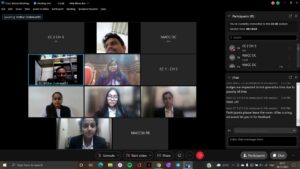
5:58 PM: All participants and the Judges have joined the session
6:03 PM: The round has commenced. Petitioner Speaker 1 has started speaking with the judges permission.
6:09 PM: The Judge 2 questions Petitioner Speaker 1 about Section 499 and asks for clarification on her statement to which the speaker responds diligently.
6:13 PM: The Judges ask Petitioner Speaker 1 questions about issue 1 and 2 and ask her the details on the facts of the case
6:21 PM: The judges also question the grounds on which the district court’s judgement is being challenged.
6:30 PM: Petitioner Speaker 2 has starts speaking on issue 3
6:40 PM: The Judge corrects Petitioner Speaker 2 for stating a wrong citation by the Supreme court and asks her to continue with her speech.
6:43 PM: The Judge questions petitioner speaker 2 about the last statement made by her about Seiji as a news aggregator and asks her about the FCRA Act .
6:45 PM: The Petitioner side completes their speech and Respondent Speaker 1 proceeds with his contentions with the permission of the judges.
6:50 PM : The Judge questions Respondent Speaker 1 about sedition as she mentioned it in her argument.
6:58 PM: The Judge has asked Respondent Speaker 1 why the government lost the election if it is not due to the failure of the government.
7:06 PM: Respondent Speaker 1 has asked permission move to the next argument.
7:22 PM: Respondent Speaker 1 has been asked a question by Judge 2 about a third person getting the information from the forum.
7:25 PM: Respondent Speaker 2 states the negative effects such as riots and deaths due to the social media and how the government has adopted a wait and watch policy and has now asked permission to share her compendium which was granted.
7:48 PM: Respondent Speaker 2 is now addressing her final issue.
7:55 PM: The Rebuttal round has commenced.
8:00 PM: The rounds have come to an end. The court is adjourned.
Court Hall 6:
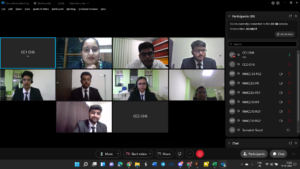
5:50 PM: All Participants have joined the court hall
5:56 PM: Both Judges have joined the meeting.
6:01 PM: The petitioner speaker seeks permission from the judges to commence with the arguments.
6:05 PM: The Judge requests a clarification regarding the facts of the case from petitioner speaker 1.
6:13 PM: The Judge questions Petitioner Speaker 1 on facts of the case and how the government is at fault in the given case. Petitioner Speaker 1 defends her statement.
6:21 PM: The Judges ask petitioner speaker 1 questions about issue 1 and 2 and ask on what grounds the district courts judgement is being challenged.
6:26 PM: Judge 2 questions the speaker in regards to the overall aim of the speaker in approaching the bench.
6:27 PM: Petitioner Speaker 2 proceeds to the prayer.
6:29 PM: Respondent Speaker 1 takes the permission of the bench to proceed with her contentions.
6:38 PM: The judges question the speaker in regards to government control over Seiji.
6:49 PM: Respondent Speaker 1 concludes their arguments
6:50 PM: Respondent Speaker 2 proceeds with their arguments.
6:53 PM: The Judge questions the speaker regarding the use of commentaries in the submitted memorial.
7:07 PM: Respondent Speaker 2 moves on to the prayer.
7:08 PM: Rebuttals have begun.
7:10 PM: Sur-rebuttals have begun
7:12 PM: Rounds have come to an end. The court is adjourned.
Court Hall 7:
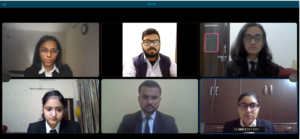
5:43 PM: The participants have joined the court hall.
5:55 PM: Both the Judges have joined the court hall.
5:57 PM: With the permission of the judges, speaker 1 for the petitioner proceeds with the facts of the case.
6:04 PM: Petitioner Speaker 1 is answers the questions put forward by one of the judges regarding the facts of the case.
6:10 PM: On being asked if a citizen can go against the state for public order, Petitioner speaker 1 cites Article 19, Clause 2 and responds by saying that open criticism comes under the right to free speech and expression.
6:15 PM: Petitioner Speaker 1 moves on to the next issue.
6:21 PM: Petitioner Speaker 1 submits the prayer to the bench.
6:26 PM: Speaker 2 for the petitioner questions the IT rules 2021 and states that they violate Article 14, Article 21 and Article 19 of the Constitution and also violates the Fundamental Right to speech and expression.
6:30 PM: Speaker 2 for the petitioner answers the questions posed by the judges as to the justification of a statement made by her regarding the IT rules violating article 21.
6:34 PM: The petitioner speaker 2 moves on to the prayer.
6:40 PM: Speaker 1 for the respondent has approached the bench and has started with his opening statements.
6:44 PM: Respondent Speaker 1 cites examples and says that blocking Indu’s access to the accounts of the ministers was not a violation of freedom of speech and expression, the act being one that just prevents her from tagging them and with a lot of other sources in hand to criticize and put up her ideas.
6:49 PM: Speaker 1 for the respondent moves onto the next issue regarding copyright and fair dealing policy.
6:54 PM: Speaker 1 for the respondent wraps up his arguments. Respondent Speaker 2 approaches the bench and with the permission of the judges, starts with his arguments(contention 3 and 4).
6:57 PM: Speaker 2 for the respondent confidently answers the question posed by the judges.
7:05 PM: Speaker 2 for the respondent has started with the fourth contention as to whether the notice issued by the government to Seiji is valid.
7:07 PM: Speaker 2 for the respondent goes about stating the FCRA and is answering a question posed by the judges regarding the facts of the case with respect to Foreign Contributions and Regulation Act.
7:11 PM: On being asked by the judges, speaker 2 for the respondent reads out Section 2(h) under FCRA.
7:17 PM: Speaker 2 for the respondent moves onto prayer Speaker 1 for the petitioner starts with the rebuttal in response to which speaker 2 for the respondent lays down his arguments.
7:21 PM: The rebuttals and sur-rebuttal have come to an end.
7:25 PM: The rounds have come to an end. The court has adjourned.
Court Hall 8:
5:50 PM: The participants have joined the court hall.
6:00 PM: Both the judges have joined the meeting.
6:02 PM: With the permission of the Judge, Petitioner Speaker 1 has approached the bench and has started stating the statement of jurisdiction and the facts of the case.
6:13 PM: Petitioner Speaker 1 has cites the Maneka Gandhi v Union of India and talks about freedom of speech and expression.
6:15 PM: Petitioner Speaker 1 submits all his contentions for issue 1 and proceeds to issue 2 .
6:21 PM: With the judges’ permission, Petitioner Speaker 2 starts with her arguments regarding Issue 3 and mentions Shreya Singhal v. UoI.
6:32 PM: With the permission of the judges, Petitioner Speaker 2 proceeds to arguments for Issue 4.
6:35 PM: Petitioner Speaker 1 has confidently answers the question posed by the Judge.
6:38 PM: Petitioner Speaker 1 has concludes his submissions regarding the infringement of the rights of Balbir Singh.
6:40 PM: With the permission of the Court, Petitioner Speaker 2 proceeds with the Prayer.
6:42 PM: With the permission of the Court, Speaker 1 for the respondent mentions the facts of the case.
6:43 PM: Respondent Speaker 1 has starts with his arguments on Issue 1.
6:45 PM: The judge poses a question regarding the right to protest of Indu. Respondent Speaker 1 responds by saying that he is not in a position to answer the question and with the permission of the judges moves on to his arguments on Issue 2.
6:50 PM: Respondent Speaker 1 concludes his submissions.
6:58 PM: With the permission of the Court, Respondent Speaker 2 starts with her arguments on issue 3.
7:00 PM: The judge poses a question regarding how an action can be taken against an intermediary like Seiji. Respondent Speaker 2 answers the same.
7:05 PM: With the permission of the judges, Respondent Speaker 2 has moved on to Issue 4.
7:12 PM: The judges pose a question to the speaker as to how Seiji is a political organization. The speaker answers it by saying that although prima facie they may not be a political organization but that it was their algorithm that made them one.
7:16 PM: Respondent Speaker 2 has concludes her arguments.
7:17 PM: With the permission of the judges, Respondent Speaker 2 has moves on to the Prayer.
7:19 PM: The rounds have come to an end. The court is adjourned.
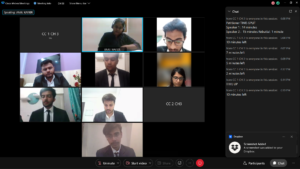
Court Hall 9:
6:20 PM: The Judges have joined and the rounds begin.
6:20 PM: Petitioner speaker 1 has started stating the statement of jurisdiction with the permission of the judge.
6:23 PM: Speaker 1 has started speaking on his arguments on issue 1.
6:25 PM: Judge questions Petitioner 1 on how Article 12 can be applied when it comes to public function.
6:28 PM: Judge questions Petitioner on whether he is making arguments based on the current issues in India or on the facts sheet.
6:29 PM: Judge asks Petitioner 1 to state the facts of a case that the Petitioner had cited.
:32 PM: Judge questions petitioner 1 on whether article 19 is affected while restricting the freedom of expression while publishing your views on an internet based medium, the Bennett Coleman case was cited by the petitioner to which the judge questioned the petitioner on the facts of the case. Petitioner 1 answered the same with confidence.
6:38 PM: Petitioner 1 is done with opening statements and arguments on the issues he has taken up.
6:44 PM: K Puttaswamy case law was stated by petitioner 2 to establish the judicial order or review requirement while the case of tracing the origin of an online publication takes place.
6:47 PM: Judge questions petitioner 2 on the safe harbor principle stated by him in his arguments. Judge further asks how the right to privacy is infringed through the post that has been made and the requirement for privacy on a public forum.
6:52 PM: Petitioner begs the council for an extra minute to further elaborate his arguments on issue 2.
6:55 PM: Petitioner 2 goes ahead with the prayer on behalf of the petitioner’s side and ends the arguments.
6:59 PM: Respondent 1 continues with issue 1 and states a statement from the Proposition to which she was questioned on the fact sheet.
7:05 PM: Article 19(2) security of state was stated by Respondent 2 in regards to Ratan Chand Banghia v Union of India case.
7:10 PM: Respondent 2 closes up with her arguments on issue 1 and calls the Co Council to speak on issue 3 and 4.
7:15 PM: Respondent 2 goes ahead with the argument on issue 3 and 4. Judge further questions respondent 2 on if the details of the user providing their details to the Government act’s as infringement of the Right to Privacy and the 3 tests under the Puttaswamy case.
7:27 PM: Judge asks Respondents to elaborate further on issue 4 on the facts that the news aggregator comes under section 4 of the IT rules.
7:33 PM: Both teams have been asked to give their rebuttals. The Petitioner takes the lead with starting off with rebuttals.
7:40 PM: The Court Hall has been adjourned.
Court Hall 10:
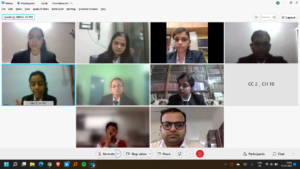
5:58 PM: With the permission of judges, PS 1 has approached the bench and started their case and would deal with issue 1 and 3.
06:00 PM: Speaker 1 started with issue 1 and cited Maneka Gandhi’s case and is speaking about freedom of speech and expression. Further, that mere criticism of the state is not a violation of their right. Cited the case of Zaved Ali v State of Delhi.
6:03 PM: Counsel highlighted essentials of defamation and stated the intention of Indu.
6:08 PM: Counsel states the rule 3 of IT act and talks about section 43A of the parent act and highlights how it is beyond the scope of parent act.
Counsel talks about how the new rules have exceeded the scope and excessive legislation. And begins to talk about rule 3(1)b and states it does not have constitutional backing. Counsel cites Shreya Singhal’s case.
6:12 PM: Petitioner Speaker 1 proceeds with second submission of issue 3 and highlights the concerning aspects of the service provider who have end to end encryption.
6:18 PM: Petitioner Speaker 2 starts with issue 2 and talks about how the video publication without license is not a violation.
6:23 PM: Judge 2 questions about the purview of the video and asks that it can be within the purview of research and asks for cases to support. Petitioner Speaker 2 states the case of Campbell.
6:28 PM: Petitioner Speaker 2 states how the platform was clearly within the ambit of the definition and says it cannot be considered as a news aggregator. Judge 2 questions that it comes under purview of news aggregators as per IT Act.
6:33 PM: Respondent Speaker 1 speaks about the reasonable restrictions of article 19. Talks about how the post posted by Indu created a threat to public peace and order.
Judge 2 questions about the reasonable restrictions and how presenting one’s opinion is under the freedom of an individual.
6:44 PM: Respondent Speaker 1 talks about the right to privacy. Judge 2 questions by saying that some of the rules are vague in nature and how rule 3 gives a lot of scope. Respondent Speaker 1 speaks about rules 3(1)d and how it states certain instances that fall under the scope and the conditions when it will be considered unlawful.
6: 57 PM: Judge 1 questions how this case is relevant to the present case. Respondent Speaker 2 says that Dhriti Tiwari does not have any valid reason to share the video and that it is a copyright infringement.
7:03 PM: Respondent Speaker 2 states The paragraph 9 of the fact sheet and says that Seiji as a platform can be used by anyone. Judge 1 questions that you can’t say that the platform itself is at fault.
7:05 PM: Judge 2 questions that govt losing elections can be based on different factors and that the platform cannot be blamed.
7:10 PM: Respondent Speaker 1 responds how the government has the provision to block certain content and talks about how defamation is ground under article 19. Says that traceability would be used as a last resort.
7:13 PM: Court is adjourned
Court Hall 11:
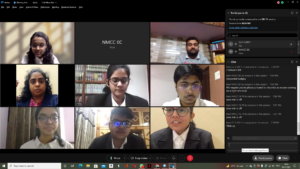
6:24 PM: Rounds begin
6:25 PM: Speaker 1 for the petitioner approaches the bench and proceeds with issues.
6: 27 PM: The Judge asks the speaker to summarize the issue briefly.
6:35 PM: Speaker 1 answers the question confidently, and talks about Article 12 and the Right to access information on access and how it has been declared as a constitutional right.
Speaker 1 asks permission to further proceed with the arguments.
Speaker 1 moving to the last argument of Issue 1.
6: 36 PM: Counsel states Jagjivan Ram case, and the Apex Court’s judgement hereafter. Speaker 1 moves proceeds with arguments for Issue 2.
The counsel talks about ‘Fair Dealing’, along with the TRIPS Agreement and Burn Convention. The counsel further elaborates that ‘Fair Dealing has been mentioned in section 52 of the Copyright Act 1957.
6:40 PM: Speaker 1 wraps up arguments for Issues 1&2, exceeding the time by 3 mins. Speaker 2 approaches the Bench and gets permission to proceed with arguments for Issues 3&4.
6:50 PM: Speaker 2 argues that the Rules 2021 are not completely reasonable. Speaker 2 wraps up arguments for Issue 3 and proceeds to Issue 4. Speaker 2 argues that Rules 4(2) tracks the first originator of information, which is against the rights of citizens. Judge 2 poses a question that in this age of cyber crime, is it not necessary to track the originator of such information.
6:57 PM: Counsel asks for proceeding with the Prayer. Counsel begins with the Prayer.
7:04 PM: Counsel mentions Babu Parate v. State of Maharashtra case. Argues that the restrictions are necessary for public order.
7:25PM: Counsel argues that the notice issued to Seiji is correct.
Counsel argues for Copyright violation and fair use policy, and talks about the Super Cassettes Industries v. My Space Inc. case.
7:38 PM: Speaker 2 starts with the rebuttals for the petitioner’s side.
Speaker 2 concludes with rebuttals.
7.45PM: Court Hall adjourned.
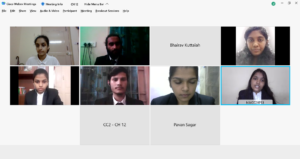
Court Hall 12:
5:59 PM: Both judges joined and we have started with the rounds
6:00 PM: Speaker 1 on the petitioner’s side has started and she explained the issues in brief . Speaker 1 talks about violation of freedom of speech and expression.
06:09 PM: She stated Romesh Thapar v. State of Maharashtra – Freedom to hold opinions . Judge asks her how all her arguments stand and asked her to explain to the court . He further questioned if the petitioner made a wrong statement would she still be at fault. But speaker 1 was not able to do justice to her answer.
6:10 PM: Speaker one on the petitioner’s side concluded strongly.
6: 15 PM: Speaker 2 on the petitioner’s side . She answered the question that was asked to her co- counsel . Speaker 2 talks about how the petitioner had 2 grounds on how her actions did not result in defamation.
6:23 PM: Speaker says Copyright infringement has not been committed in this case . It would be corporate infringement if she received money for it , but in this case she does not get money.
6:25 PM: Section 52 of the Corporations act was mentioned as an exception.
6:30 PM: Petitioner Speaker 2 humbly submits their submissions and seeks permission for the prayer and states the prayer.
6:35 PM: Respondent Speaker 1 speaks about the three fold test of reasonable restrictions and how it is being fulfilled by the Indu’s post and hence the govt has merely exercised their right under reasonable restriction.
6:37 PM: Judge 2 questions about how the prime minister comes within the ambit of the state and how the government should take serious action when there is threat on the prime minister and when the state is at stake.
6:44 PM: Respondent Speaker 1 talks about the right to privacy. Judge 2 questions by saying that some of the rules are vague in nature and how rule 3 gives a lot of scope. Respondent Speaker 1 speaks about rules 3(1)d and how it states certain instances that fall under the scope and the conditions when it will be considered unlawful.
6:50 PM: Respondent Speaker 2 seeks permission to begin with issue 2.
6:56 PM: Respondent Speaker 2 Cites Shibani v Rajat Mukherjee’s case and talks about reproduced work and fair dealing policy.
7:03 PM: Respondent Speaker 2 states the paragraph 9 of the fact sheet and says that Seiji as a platform can be used by anyone. Judge 1 questions that you can’t say that the platform itself is at fault.
7:10 PM: Judges ask participants to go ahead with the rebuttal.
7:13 PM: The rounds come to an end. Court has adjourned.
Court Hall 13: Not Functioning
Court Hall 14:

6:02 PM: Speaker1 has started speaking – summary of facts
6:04 PM: Speaker starts with issue 2 and 3
6:07 PM: :Judge poses the question to the counsel to substantiate the position of reproduction of an already existing video and proceed with the corresponding arguments.
6: 11PM: Speaker 1 places reliance on foreign judgments based on transformative and original work
6:13 PM: Persuasive or binding judgement- question posed by the judge
6:15 PM: Annexure 6 of the FDI policy was mentioned in the argument.
6:18 PM: The concept of Natural justice and violation of audi alteram partem was raised in the argument.
6:20 PM:The Petitioner speaker 2 has moved on to the statement of arguments on issue 3
6:22 PM: The case of Shreya Singal v UOI, was cited in the arguments regarding issue 3, stated by the Petitioner speaker 2.
6:23 PM: In the argument based on issue 3, Maneka Gandhi v UOI, was also cited.
6:27 PM: Additionally, Nagar Ahmed v King Emperor was also cited.
6:30 PM: No questions from the part of the judges have been asked so far. State of Karnataka v. Ganesh Kamath was mentioned in the arguments on issue 3.
6:31 PM: With the permission of both the judges, the Petitioner speaker 2 has proceeded to prayer.
6:34 PM: The Respondent speaker 1 has approached the Bench The Respondent speaker 1 has commenced with the statement of issues.
6.38 PM: Speaker 1 starts speaking and explains time splits
Indus speech should not be protected due to reasonable restrictions.
6.42 PM: Judge asks the counsel to relate the facts of the present case to the citation referred by the counsel. Public interest is of a wide scope
6.45 PM: Counsel places reliance on Kedarnath case, sedition and critical speech.
6.48 PM: Court of Nanda doesn’t recognize US judgements- only commonwealth countries admissible
6.51 PM: Argument made- Section 52- fair dealing clause can be used as defense in case of artistic work. In present case, since the video doesn’t come within the purview of artistic work, petitioner has to be held liable.
7:20 PM: The Rounds come to an end. Court Hall adjourned.
Court Hall 15:
6.00 PM: Judges Joined
6:08PM:The Petitioner Speaker 1 has approached the bench, and sought permission to state the facts
6:10PM:The Petitioner Speaker 1 has proceeded to the issues
6:11PM:The Petitioner Speaker 1 has commenced with the statement of arguments on issue 1
6:13PM: SG Jain Singhani v UOI, was cited in the argument regarding issue 1.
6:14PM: The Petitioner speaker 1 has moved on to issue 4
6:15PM: In the argument made by PS1, Section 9A was said to be violative in nature
6:17PM: Annexure 6 of the FDI policy was mentioned in the argument.
6:18PM: The Petitioner speaker 2 has approached the bench and commenced with her arguments on issue 2.
6:22 PM: The Petitioner speaker 2 has moved on to the statement of arguments on issue 3
6:23 PM: The case of Shreya Singhal v UOI, was cited in the arguments regarding issue 3, stated by the Petitioner speaker 2.
6:26 PM: In the argument based on issue 3, Maneka Gandhi v UOI, was also cited.
Further, the PS2 has cited the case of K.S Puttaswamy v UOI in the argument.
6:32 PM: State of Karnataka v. Ganesh Kamath was mentioned in the arguments on issue 3.
With the permission of both the judges, the Petitioner speaker 2 has proceeded to prayer.
6:33PM: The Respondent speaker 1 has approached the Bench The Respondent speaker 1 has commenced with the statement of issues.
6:34 PM:The Respondent speaker 1 has commenced with arguments on issue 3. The arguments stated by speaker has included responses to what was stated by the Petitioner.
6:36 PM: The Respondent speaker 1 has concluded his arguments and contentions and has moved onto the arguments on issue 4.
6:39 PM: The platform Seiji was stated to be utilized for political motives, as argued by RS1. The Respondent Speaker 1 has concluded that the notice issued to the petitioner was valid in law, and further argued that the petitioner was in the direction of a conspiracy theory.
6:44 PM: The Respondent Speaker 2 has approached the bench and has commenced with the statement of arguments on issue 1.
6:47 PM: The RS2, has contended that Indu was instigating dissents, and the citizens to revolts in the country.
6:49 PM: The Counsel has commenced with the statement of arguments on issue 1.The Judge 2, has asked the Petitioner speaker 1 about why Indu’s right was violated in respect to Article 14.
6:50 PM: The Speaker 2, has contended that Indu was instigating dissents,hate speeches and revolts in the country.
6:54 PM: Speaker 2 has cited OM Prakash v Emperor in the arguments.
6:54 PM: The Speaker 2 has commenced with the statement of arguments on issue 2.
The Respondent Speaker 2 has finished the arguments and has proceeded to prayer.
6:59 PM: The Judge Further added on with the question of conflict between right to equality and right to political equality. The Speaker 1 confidently answered about the political right being a human right and how her equality was denied when she was denied access to a public forum.
7:00 PM: Judge 1 has further added that Indu’s freedom of speech and expression was being violated.
7:05 PM: The Judge 2 has emphasized that Seiji just like twitter convey messages around, however Indu’s access to information is not restricted rather it is accessible even through other web platforms. Furthermore, Judge 2 stated that Indu was onto her goal of achieving political mileage and popularity in social media.
7:09 PM: Judge 1 has stated further on freedom of speech and expression.
The Judge 2 has stated his opinion on fundamental rights.
7:12 PM: The Petitioner contended that the algorithm of the platform, Seiji was biased.
7:15 PM: The Petitioner Speaker 2 has commenced with the rebuttal. Speaker2, has contended that on what basis was the Respondent questioning the maintainability of the case.
7:20 PM: The Court hall has been adjourned.
Court Hall 16:
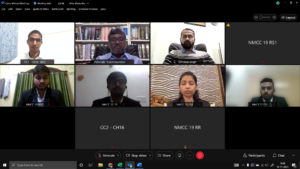
6.04 PM: Judge 1 has joined the court hall
6.08 PM: With the permission of the bench, PS1 has approached the bench and would be dealing with issues 1 and 2
6.10 PM: Speaker has cited Maneka Gandhi v. UOI
6:13 PM: Speaker is questioned on the Accountability of the PM.
6.15 PM: Speaker confidently answers the questions raised by the bench
6:19 PM: Judge 2 questions speaker on the policies employed by the government.
6.21 PM: Speaker 1 is granted permission to continue with the arguments
6: 22 PM: Speaker substantiates their arguments by citing Vijayadhalini v.UOI
6.27 PM: Counsel is questioned on the use of demon emoji for character assassination of the PM.
6.28 PM: Counsel concludes issue 1 and moves onto the second issue.
6: 29 PM: Judge grants 2 minutes to conclude the issue 2 minutes.
6.31 PM: No questions from the part of the judges have been asked so far.
6.34 PM: Counsel cites the case of Aparna Bhat v State of MP
6.35PM: Judge questions counsel on the problems in complying with guidelines in India.
6.37 PM: Counsel answers the second question posed by the bench regarding the violation of right to privacy.
Speaker moves to answer the question 1 posed by the judge regarding the imposition of reasonable restrictions.
6.41 PM : Speaker cites the cases of UOI v. Association for Democratic Reforms and Anuradha v. UOI
Speaker cites Justice Puttaswamy judgment.
6.44 PM: Judge 1 questions the validity of the argument and the scope of misuse of information by the government.
6.48 PM: Speaker begins with the prayer.
6.49 PM: Counsel approaches the bench and begins with arguments. PS2 will deal with issues 3 and 4. Speaker draws reference to the last sentence of the preamble.
6.51PM: Speaker begins with issue no. 4. Foreign conservation and Regulation Act is relied on by the counsel.
6.56 PM: Counsel approaches the bench and seeks permission to address issue 1.
6.58 PM: Judge questions counsel on the govt. targeting Seiji.
7.01PM : Speaker approaches the bench and seeks permission to address issue 1.
7.07 PM: Clause 1 of RTI Act referred to by speaker.
Speaker questioned on the basis of copyright infringement.
7.17 PM: Speaker proceeds with the prayer.
7.20 PM: Judge proceeds to provide the participants with the feedback.
7.30 PM: Court Hall adjourned.
Court Hall 17:
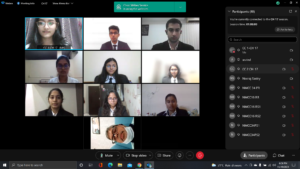
6:07PM: Petitioner speaker 1 seeks permission to address the bench. Judge 1 asked the counsel to address them as “your honour”.
6:08PM: Counsel starts with the brief facts of the case.
6:11PM: Speaker states Shreya Singhal v. UOI and is arguing on Freedom of speech and expression. UOI V. Motion Pictures Publication is cited by the Judge.
6:13 PM: S. Ranganathan v. P Jagdeep Raj- Right to criticize.
6:15 PM: Judge 1 interrupts and asks whether the Ministers as the part of their privacy can they block the citizens.
6:17 PM: Speaker talks about Article 19 (1) (a) Right to information and states that Ministers by blocking her account are depriving her of her fundamental rights.
6:20 PM: Article 13 of trade related questions of the Act is being cited.
6:22 PM: Judge 2 interrupts and asks whether the video was necessary to be blocked as a part of infringement of copyrights.
6:23 PM: Concludes the second issue and asks co-counsel 2 to continue with issue 3 and 4 and PS2 seeks permission to address the bench.
6:24 PM: Judge 2 asks whether the Court of Nanda considered dealing with regard to K.S Puttaswamy v. UOI case and quotes the judgement of the court.
6:27 PM: Concludes the point saying that the rule violates the right to privacy.
6:29 PM: Seji is not liable to the actions of the public and hence the rules of blocking the users have been allowed to maintain peace and order of the public.
6:32 PM: Talks about section 17 and rule 3(4) of Shreya Singh v. UoI.
6:34 PM: Government violates article that deals with freedom and expression and quotes the case and says that the rue violates the right.
6:35 PM: Moves with with 4 and submits and quotes Section 2(4) of IT Act.
6:39 PM: Seji has not acted without the ambit of law.
6:41 PM: Cites Benet Colon v. UOI case to substantiate the point.
6:42 PM: Section 3 of Foreign Contribution and regulation Act and says that Seji is a social media platform and does not come under the above said section.
6:44 PM: Counsel seeks the permission to move with the prayer to which Judge 2 states that prayer is on record.
6:48 PM: Article 19(1) talks with the freedom of speech and expression and states that Article 19 (2) deals with regard to reasonable expression. Further cites Shreya Singhal V. UOI case. States that Seiji is not a government platform to deal with all government issues and is a public website.
6:50 PM: The Counsel Argues on Violation of fair use policy of Driti Tiwari and is arguing confidently and Takes Precedent of 1968 case to substantiate the points.
6:56 PM: Judge 2 interrupts asking – By blocking Indu doesn’t it violate citizens right? To which the counsel answers confidently stating that Seji has given access to block whomever required and has violated others rights and dignity.
6:57 PM: Counsel concludes her argument on first issue and with the permission moves to the issue 2.
6:58 PM: Counsel argues on Violation of fair use policy of Drithi Tiwari and is arguing confidently and Takes Precedent of 1968 case to substantiate the points.
7:01PM:RS1 has exceeded her time and hence the Judge 2 asks the council to summarizes her points.
RS1 speaker rests with her argument meanwhile RS2 proceeds with issue 3.
7:02 PM: Tarun Dutt V. UOI case is being cited.
IT clause 21 false under Article 19 (2) reasonable restrictions.
7:04 PM: Judge asks with regard to how the states determine / the standards to determine the reasonable restrictions. RS2 struggles to convince the judge.
7:06PM: Mohammad Qureshi V. State of Bihar, cites the case law to substantiate the argument.
Judge2 interrupts on how the IT rules 2021 supports the parent act?
7:09 PM: Anushkar V. UOI case law is cited with regard to need to restrict illegal posts eg, child pornography and so on.
7:10 PM: The Counsel proceeds with issue 4,
7:11 PM: The Counsel submits her argument and seeks permission to move with the prayer.
7:27 PM: The Court Hall has been adjourned.
With this DAY 2 comes to an end! See you guys tomorrow for the Octa-final rounds tomorrow.
Let us begin Day 3!
The Octa-final Rounds will begin shortly. All the best wishes to the participants.
10: 47 AM: The Judges Briefing session is in progress.
Octa- Final Rounds:
Court Hall 1:
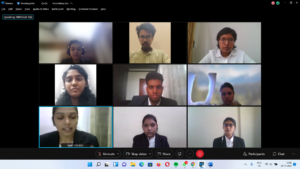
11:01 AM: Both the judges have joined the meet and the rounds have commenced.
11:02 AM: Petitioner Speaker 1 has started with the arguments and is taking up issues 1 and 3.
11:05 AM: The Judge asks petitioner speaker 1 whether Indu has been prohibited from expressing herself elsewhere and whether Indu could get information from sources apart from SEGI.
11:07 AM: Judge asks Petitioner Speaker 1 to draw parallels for his contention with the proposition. Judge also puts forth a point saying Indu is not prohibited from expressing herself on other platforms.
11:09 AM: Petitioner Speaker 1 proceeds to issue 3. Petitioner Speaker 1 quotes Shreya Singhal v. UoI and talks about tools to remove inaccurate content.
11:13 AM: Judge asks Petitioner Speaker 1 what the reasonability test is and to elaborate on the same. Petitioner Speaker 1 quotes the K.S.Puttaswamy v UoI and proceeds to answer the question.
11:18 AM: Judge asks petitioner speaker 1 why a political party should be classified as a public authority and how the government documents are public documents.
11:21 AM: Petitioner Speaker 2 explains why Section 66A was scored out and section 69 A was introduced and says that the government is only trying to control social media in India or offices in India.
11:26 AM: Petitioner Speaker 1 brings in the Disha Ravi Toolkit case and Parameshwaran case and compares Disha Ravi and Indu.
11:28 AM: The Judge asks Petitioner Speaker 2 the definition of a public interest litigation. Petitioner Speaker 2 proceeds with issue 2 and 4. The judges ask petitioner speaker 2 to clarify the issues that she is contending with.
11:32 AM: The Judge asks how the video is linked to the article. Petitioner Speaker 1 proceeds with freedom of speech by quoting the Naveen Jindal v Union of India.
11:35 AM: The Judge asks about Sec 52 of the Copyrights act. Petitioner Speaker 1 answers the question by referring to the proposition.
11:37 AM: Petitioner Speaker 2 proceeds with the prayer.
11:45 AM: Respondent Speaker 1 proceeds with issue 1 and says that Indu is defaming the government to defame the government. Judge asks how emoji can be described as defamation. Respondent Speaker 1 quotes Australian case law Burroughs v. Honda Manufacturing of Alabama, LLC to say how emoji is considered as defamation.
11:56 AM: Judge asks Respondent Speaker 1 to define sedition. Respondent Speaker 1 brings in Kedarnath Singh V State of Bihar to define sedition and its ingredients.
11:58 AM: Respondent Speaker 2 proceeds with issues 2 and 3 with the judges permission. Respondent Speaker 2 talks about two aspects of Drithi Tiwari to Balbir Singh and the Fair use principle. Judge asks Respondent Speaker 2 to explain how there is no Fair use application as stated earlier.
12:01 AM: Judge asks respondent speaker 2 how reviewing and criticism is always negative. Respondent Speaker 2 responds by stating Section 52.
12:06 AM: The Judge asks how merely taking 14 words from the paper is copyright infringement.
Court Hall 2:
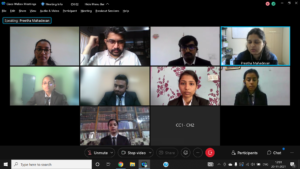
10:57 AM: With the permission of the judge, Petitioner Speaker 1 seeks permission to address the bench and approaches the bench. Round Begins. Petitioner Speaker 1 will address issue 1 and 2 and proceeds.
10:58 AM: Petitioner Speaker 1 speaks about the right to freedom and speech and cites the case of Maneka Gandhi v. UoI.
11:00 AM: Petitioner Speaker 1 speaks how govt. ‘s actions have infringed the freedom of speech and expression of Indu and then goes on to talk about how the blocking of Indu’s content is arbitrary. Petitioner Speaker 1 talks about malafide intentions of the govt. for blocking the content and taking support from Maneka Gandhi’s case.
11:07 AM: Petitioner Speaker 1 cites K Murari case and talks about infringement of copyright issue and pecuniary rights. Petitioner Speaker 1 talks about how Dhriti Tiwari’s video does not have any commercial aspect and states article 52. Petition Speaker speaks about the video by Tiwari her opinion and she is entitled to her opinion and thought. Petitioner Speaker 1 then proceeds to talk about the originality of work and how it must originate from the author.
11:10 AM : Petitioner Speaker 1 talks about the intention of sharing the video and is in public interest. Petitioner speaker 1 submits that there has been no copyright infringement and rests their issues.
Judge 2 poses questions about how the video of Tiwari was in public interest. Petitioner Speaker 1 answers by telling the intention of Tiwari.
Judge 1 poses a question that the PM has the right to block anyone from the account and asks for any laws that ban it.
11:11 AM: Petitioner Speaker 2 starts with issue 3 and Cites the state of Karnataka case relating to the IT act and shows how the IT rules travel beyond the scope of the parent act. Petitioner Speaker 2 speaks about rule 4 of the IT act and end to end encryption options.
Petitioner Speaker 2 submits that IT rules are ultra vires and that it has a chilling effect on the freedom of speech and expression of the citizens. Petitioner Speaker 2 goes on to talk about article 21 and cites the Puttaswamy case and talks about rule 4(2) of IT act.
11:23 AM: Judge 1 questions whether news aggregator is defined under any laws and asks why Petitioner Speakers are approaching the court. Petitioner Speaker 2 answers by stating the definition under IT act and that they approached the court under article 226.
11:30 AM: Respondent Speaker 1 cites Shreya Singhal’s case and there are provisions for central govt to block any content and then Cities Subramaniam Swamy’s case to support right of free speech and D C Saxena’s case. Speaks about defamation.
11:31 AM: Respondent Speaker 1 speaks about the intention of indu and supports various instances from the facts.
Judge 2 poses questions on the matrix of defamation and difference between matrices of citizens and Prime minister. Respondent Speaker 1 then submits issue 1 and begins with issue 3.
11:35 AM: Respondent Speaker 1 supports their argument based on rule 3(1)d of the act. Cites Kesavananda Bharati case.
Respondent Speaker 1 highlights reasonableness and proportionality test of freedom of speech and expression.
11:40 AM: Respondent Speaker 1 submits their arguments and Judge 2 poses a question on sedition and states case of Kedarnath and asks their reasoning how it falls under that ambit. Respondent Speaker 2 Begins by seeking the permission from the judges. Respondent Speaker 2 would be dealing with issue 2 and 4.
11:45 AM: Respondent Speaker 2 supports the argument that the video posted by Tiwari is violating the copyright since it was shared with the general public and talks about the intention of publishing the video. Respondent Speaker 2 proceeds with the second contention that talks about license.
11: 51 AM: Respondent Speaker begins with issue 4 and talks about the meaning of news aggregator. Respondent Speaker 2 states section 48 of the FCI act. Respondent Speaker 2 submits their arguments.
11:54 AM: Respondent Speaker 2 states the prayer. Counsel 1 poses a rebuttal and states that Dhrithi is acting as a private citizen and poses the question that there is no defamation in this case.
11:56 AM: Respondent Speaker 1 answers the rebuttal by stating that there was an instance where the protest was peaceful and cannot be supported from the facts. And states article 19(2) in support.
12:00 PM: The Round has come to an end. The Court Hall is adjourned.
Court Hall 3:
11.14 AM : Speaker 1 from the petitioner’s side has asked for permission to approach the bench. Speaker 1 has begun with the facts of the case.
11:22 AM: Speaker 1 explained the Ram Manohar Case.
11:23 AM: The judge questioned the counsel about the correlation of the above case with the facts at hand. The counsel elaborated on the arbitrariness of 69(A) of the IT Act.
11.23 AM: The judge has questioned the counsel on the responsibilities of the ministers and the counsel explains the same. She elaborates on how the government is not on friendly terms with the public.
11:31 AM: The judge asks the speaker to move onto issue 2. The speaker discusses the basics of copyright contravention in four limbs. The judge follows up with a question where he questions the speaker on the basics of intellectual property rights.
11:33 AM: The speaker discusses Section 51 of the Copyright Act with reference to Balvir’s copyright.
11:36 AM: Speaker 2 from the petitioners side seeks permission to approach the bench and states that she will be dealing with issue 3 and 4.
11:38 AM: The counsel elaborates on how the impugned rules have a chilling effect of freedom of speech and expression and is violative of Article 21 of the Constitution. The judge questions the counsel on whether the High Court can check the constitutional validity of the Acts.(Art 226)
11:39 AM: The speaker discusses about Article 14 and elaborates on the case of Shreya Singhal v. Union of India.
11:42 AM: The counsel 2 speaks about how the impugned rules are beyond reasonable restrictions and backs it up with the case of Romesh Thapar.
11:43 AM: The counsel discusses the first originator of a social media intermediary.
11:46 AM: The counsel states the facts of the case of Maneka Gandhi v. UOI
11:47 AM: Counsel 2 for petitioners concludes with issue 3 and seeks permission to issue 4.
11:49 AM: The judge questions the counsel on the kind of writ petition filed in this case.
11:50 AM: The petitioners submit their prayer before the Hon’ble Court.
11:51 AM: The counsel for Respondents seeks permission to begin their argument.
11:55 AM: The counsel elaborates that blocking the handle of Pratap is not unlawful.
11:57AM:The counsel speaks about the case of Subramanya Swamy.
11:59 AM: Amish Devgan v. UOI was discussed in detail by the speaker 1.
12:04 PM: The speaker elaborated on what words constitute defamation.
12:06 PM: The judge questioned the counsel on whether defamation is a part of the IPC or not. The counsel answered accordingly.
12:07 PM: The counsel summarizes issue 1 by elaborating on fair defense.
12:08 PM: The counsel states that though Drithi Tiwari’s work was in a different mode, it does amount to copyright infringement.
12:09 PM: The counsel elaborates on what fair use is-private and personal use and criticism or review.
12:16 PM:The counsel seeks permission to approach the bench.
12:18 PM:Counsel 2 from the respondents side speaks about due diligence.
12:23 PM:The counsel elaborates on how the new IT rules are in line with the parent act.
12.30 PM: Seiji is engaged in the broadcast of news as stated by the Counsel 2.
12.40 PM: The speaker talks about the importance of social media.The speaker speaks about how all individuals have the freedom of speech and expression.
12.44 PM: The Rebuttals have started.
12.50 PM: The court hall adjourned.
Court Hall 4:
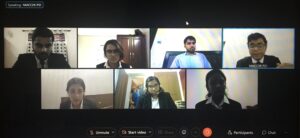
11.00 AM : Judge 1, has entered the Court Hall.
11.02 AM : judge 2, has joined
11:03 AM: Speaker 1 has started the submissions with the permission of the Court, speaker is briefing the court about the facts.
11:05AM: Speaker 1 has commenced his arguments for Issue 1, presenting a two fold argument.
11.08 AM: Judge 1 asks Speaker 1 the ambit of the word ‘State’ under Art. 12, if Seiji is under the realm of State according to the Petitioners, if not, then how it is an infringement of fundamental rights.
11.10 AM : Judge 1 has asked Speaker 1 for case laws to support his claims, Speaker is unable to answer to the satisfaction of the judge.
11.13 AM : Judges have asked the Speaker if the Petitioner’s petition is maintainable under Art 226, questioning the original jurisdiction.
11.15 AM : Judge 2 asks Speaker 1 asks if public order comes under restrictions under Art 19(2), asks speaker to read out the language in which Indu has written her post; judges are questioning the relation between the policy and the post of the Respondents.
11:17 AM: Judge 2 questions what according to the petitioner is wrong with the statements of the PM.
11:19 AM: Speaker commences Issue 2, asked to wrap up in 2 mins.
11:20 AM: Speaker cites Copy Right’s Act to state that the Dhriti Tiwari is not in violation of the Fair Use Policy, and that there is no corporate violation.
11:22 AM: Speaker 1 concludes his arguments.
11:23 AM: Speaker 2 commences his arguments for Issue 3 with due permissions of the Court.
11:23 AM: Counsel cites Shreya Singhal case, Sec 79 of IT Act, 2000 – that intermediary shall not be liable for any information relating to third parties.
11:26 AM: Judge 1 asks which part in Rule 3 to 7 are violative of reasonability tests, Speaker 2 is unable to answer the question as Judge 2 has been disconnected.
11:28 AM: Rounds resumed. Speaker 2 has answered the questions of the Judge by citing Puttaswamy Right to Privacy judgement, refers to three prong tests, cites restrictions for Art 14; answers the questions confidently.
11:30 AM: Judge 1 questioned the onus and responsibility of the public before posting content online. Speaker has answered the question confidently.
11:33 AM: Counsel cites Rule 4(2) of IT Rules 2021, Judge 1 questioned the claim of the Petitioner that there is a procedural flaw or ambiguity in the Rules; Speaker answers that there is a procedural flaw in tracing the first originator without violating end-to-end encryption.
11:37 AM: Judge 1 asks in the guise of privacy can national security and public order be put at risk, Speaker 2 does not have a satisfactory answer.
11:39 AM: Time has elapsed for speaker 2, proceeds to argue concerning Rule 4(7). Concludes that the Rules are unconstitutional and ultra vires the IT Act, cites Kartar Singh case.
11:42 AM: Speaker 2 has continued arguments for Issue 4. Asked to wrap up in 2 minutes.
11:43 AM: Under Rule 2(o), Seiji does not produce its own content or information, cites Sec 3(1)(j). Speaker has answered the question of Judge 2 confidently.
11:46 AM: Speaker asked to conclude, Judge 1 opens the floor for the respondents.
11:49 AM: Respondent Speaker 1 has commenced her arguments for Issue 1 with due permissions of the Court.
11:52 AM: Judge 1 asks if moral rights are protected under Copyright Act – Speaker 1 answers that Sec 57 protects legitimate interest of the author.
11:55 AM: Judge 1 asks how the dignity of the author is infringed in the instant case.
11:58 AM: Speaker states that literary work is not protected under Sec 57, judge 2 questions where she is drawing this conclusion from; speaker answers satisfactorily.
11:59 AM: The counsel cites Nilesh Navalakha v. UoI, Tehseen S Poonawalla v. UoI; judge 1 asks why these judgements and case laws are not included in the legislative draft to address the gray area of public interest as per law, as it is not defined anywhere.
12:02 PM: Judge asks follow up questions, Speaker cites Sec 3 and answers confidently.
12:05 PM: Speaker 1 concludes, speaker 2 commences arguments for issue 1.
12:07 PM: Speaker 2 is unable to answer the question of judge 1 regarding the gray area in the legislation; whether Indu’s accounts’ blocking is lawful or unlawful.
12:10 PM: SPEAKER Draws attention to NPC 127 A, regarding sedition, which speaks about broadening the scope of public interest. The sedition charges are in consonance with Art 19.
12:12 PM: The speaker cites the Donald Trump case, in a persuasive capacity to contend that the actions of the government are constitutional.
12:15 PM:Judge asks if the respondent speakers are accepting the fact that the government is a stakeholder in the social media intermediary, Speaker agrees.
12:17 PM: Judge 1 has asked speaker 2 to wrap and start with Issue 4. Speaker commences argument for Issue 4.
12:18 PM: Judge 1 asks the general definition of the transmission and distribution of telecommunications.
12:20 PM: Speaker 2’s time has elapsed, asked to conclude her arguments
12:23 PM: Rebuttals of the petitioners have begun, by Speaker 2.
12:25 PM:Respondent rebuttals have begun.
12.36 PM: Court Hall Adjourned
Court Hall 5:
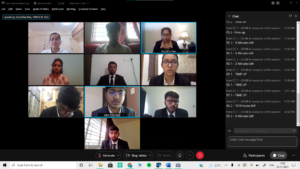 11:04 AM: Speaker 1 for the petitioner approaches the bench and with the permission of the judges, the speaker has started laying down the facts of the case.
11:04 AM: Speaker 1 for the petitioner approaches the bench and with the permission of the judges, the speaker has started laying down the facts of the case.
11:08 AM: Speaker 1 for the petitioner starts with issue 1, defends Indu and talks about the virtual fight that was aroused by the Prime minister.
11:11 AM: On being asked by one of the judges as to why a public figure like any other citizen can’t block another person through their private accounts and what the issue in doing so is, the speaker cites the case of Subhash Chandra Aggarwal saying that the private life of political figures is different from that of a normal citizen.
11:15 AM: Speaker 1 for the petitioner confidently answers the question posed by one of the judges regarding a point about the word limit of 150 on Seiji that the speaker highlighted.
11:17 AM: With one minute left, the judges have agreed to give the speaker, 2 additional minutes to go about with her fourth issue.
11:19 AM: Speaker 1 for the petitioner cites paragraph 3 of the moot proposition and highlights that Seiji doesn’t come under the restrictions in FCRA section 3(1)(g) as it is just a platform that facilitates posting of content and does not display content of its own.
11:21 AM: Speaker 1 wraps up her arguments. Speaker 2 for the petitioner starts putting forth her arguments with the permission of the judges.
11:25 AM: Speaker 2 for the petitioner cites the rules and acts under IT rules 2021 and Shreya Singhal vs Union of India.
11:28 AM: On being asked by one of the judges regarding a statement made by the speaker on the first originator of an information, the speaker confidently answers the question.
11:31 AM: The judge questions the speaker and highlights that the decryption of certain messages and information on a platform is done to protect the users . The speaker answers the question by saying that the entire content is decrypted and cites rule 4 (2) of the IT rules 2021.
11:34 AM: Speaker cites Puttaswamy judgement on being asked by one of the judges regarding breach of statutory obligation by an intermediary.
11:37 AM: With the permission of the judges, speaker 2 for the petitioner has been granted an additional 2 minutes to forward her remaining arguments and sum up. Due to time constraint speaker 2 has been asked by one of the judges to conclude without prayer.
11:40 AM: Speaker 1 for the respondent approaches the bench and has started laying down his arguments with respect to the issues in hand.
11:43 AM: Speaker 1 for the respondent cites a boys’ locker case, and a celebrity’s ten year old daughter being subjected to obscene threats to highlight that a particular content would be taken down by an intermediary on receiving a complaint by the aggrieved person.
11:46 AM: The speaker confidently articulates and answers the questions posed by one of the judges regarding the power of intermediaries to decide the legality of a content.
Speaker 1 for the respondent argues that Seiji does not have an end to end encryption which the judge questions as to the fact that the same is not mentioned in the case file..
11:55 AM: The speaker backs up saying that it is highlighted in the proposition that Seiji is similar to twitter which does not have an end to end encryption and hence the argument.
11:57 AM: Speaker moves onto issue 4.
Judge asks the speaker to keep his arguments short and precise due to paucity of time.
12:00 PM: Speaker 1 for the respondent wraps up and speaker 2 approaches the bench with her arguments on issues 1 and 2 with the permission of the judges.
12:04 PM: Speaker 2 for the respondent argues and cites clause 2 of article 19 highlighting that Indu’s comments were defamatory instigating the people to go against the prime minister, disturbing the peace and sovereignty of the nation.
12:07 PM: Speaker 2 for the respondent cites cases of Om Prakash vs Emperor, Romesh Thappar vs state of Madras and Ram Nandan vs the state on being asked by one of the judges regarding laws related to public order.
12:10 PM: Speaker 2 highlights that Indu could use other platforms to put up her content and ideas but on the other hand came up with the petition to further spread hate and violence.
12:14 PM: Speaker 2 for the respondent moves onto the next issue and is unable to answer a question posed by one of the judges.
12:17 PM: Speaker 2 for the respondent moves onto prayer.
Speaker 1 for the petitioner starts with the rebuttal
Speaker 2 for the respondent goes about with the rebuttal.
12: 21 PM: The session is adjourned.
Court Hall 6:
11:07 AM: Petitioner speaker 1 has commenced with the statement of facts with the permission of the judges.
11:09 AM: The Petitioner speaker 1 has proceeded to the submissions on issue A, beginning with the arguments.
11:14 AM: Petitioner Speaker 1 has mentioned the case of Raj Naran, by stating that blocking Indu’s access to information has violated her right to freedom of speech and expression. Further, Petitioner Speaker 1 has mentioned the case of Knight Institute v. Donald Trump.
11: 16 AM: Judge 1 has asked a question – whether the State has provided any other provisions other than what has been stated in the Constitution of Nanda.
Petitioner Speaker 1 has proceeded to the statement of arguments on issue C. He has mentioned the case of Indian Express Newspaper v UOI.
11:18 AM: Additionally he has elaborated on the test of proportionality and its limbs, after mentioning the case of K.S Puttaswamy v UOI in his arguments.
Petitioner Speaker 1 has further stated that the rules violated Article 19(1). The right to privacy and end-to-end encryption have been mentioned in one of the arguments.
The case of Shreya Singhal v UOI has also been stated.
11: 21 AM: Judge 1 has asked Petitioner Speaker 1 to address the statement used by the speaker regarding how the State. Petitioner Speaker1 has finished his submissions.
11:25 AM: Petitioner Speaker 2 has approached the bench, and has commenced with her arguments on issue B with permission of the judges.
Petitioner Speaker 2 has put forth her arguments in the lines of copyright laws in the country. Petitioner Speaker 2 has also stated two cases regarding this. In one of the arguments, PS2 has mentioned a landmark case of Civic Chandran v. Ammini Amma.
11:30 AM: Petitioner Speaker 2 has proceeded to the statement of arguments on issue D, with the permission of the judges. Petitioner Speaker 2 has highlighted Section 3 of the Foreign Regulation Act with comparison to the IT Rules.
Section 87 of the IT Act was also mentioned in the arguments.
11:36 AM: Petitioner Speaker 2 has requested the judges for an extra 1 minute. It has been granted. Petitioner Speaker 2 has stated that the notice sent by the Government is invalid in law and the blocking of Indu’s access was unconstitutional.
11:40 AM: Petitioner Speaker 2 has proceeded to the prayer.
11:41 AM: Respondent Speaker 1(RS1) has approached the bench.
Respondent Speaker 1 has commenced with the statement of arguments.
11:43 AM: Respondent Speaker 1 has mentioned RD Shetty v International Airport in the arguments. Additionally he has stated Kartikeya Varma v UOI.
11:44 AM: Respondent Speaker 1 provided a counter- mention of Knight v Donald Trump in his arguments.
Respondent Speaker 1 has stated that Indu, in the present case, has also received a decrement in her popularity not any of her rights.
11:46 AM: Respondent Speaker 1 has contended that the Petitioner’s rights have not been violated as she can still access information through other websites in the digital media.
11:53 AM: Respondent Speaker 1 has stated that the idea of transformative character is not present in the case. This was also supported with the speaker’s mention of a case. Respondent Speaker 1 has stated the Harper case of the UK.
11:56 AM: Respondent Speaker 1 has stated that the research paper had a biased comparativeness in contrast to Drithi Tiwari’s video being in a biased nature.
Judge 1 has asked Respondent Speaker 1 a question regarding the distinctions of courts in the writ of certiorari and jurisdictions. Respondent Speaker 1 has responded confidently.
11:59 AM: Respondent Speaker 1 has finished his submissions.
12:00 PM: Respondent Speaker 2 has approached the Bench and has commenced with the statement of issues
12:02 PM: Respondent Speaker 2 has commenced with the statement of arguments on issue 4.
12:03 PM: Respondent Speaker 2 has mentioned section 31 of the FCRA in his argument along with the mention of Bhubaneshwar case
Respondent speaker 2 has referred to para 9 and 14 of the proposition.
12:07 PM: Respondent Speaker 2 has highlighted Rule 5 of the IT Act, in addition to the validity of Seiji. Judge 2 has asked Respondent Speaker 2 to elaborate on the Safe harbor principle.
12:10 PM: Respondent Speaker 2 has confidently responded by stating Seiji’s eligibility for such protection under the Act.
12:12 PM: Respondent Speaker 2 has proceeded to the statement of arguments on issue 4. Respondent Speaker 2 has further mentioned the case of Shreya Singhal v UOI with respect to section 69 of the Act. Indecent Representation of Women Act, IPC and POCSO were also mentioned in one of the arguments.
12:15 PM: Respondent Speaker 2 has mentioned the case of Alakh Alok Srivastava v UOI 2020 in one of the arguments.
The elements of the test of reasonableness were described with respect to the case.
The test laid down in K.S Puttaswamy case was addressed.
12:17 PM: Judge 1 has asked Respondent Speaker 2 to address the issue of right to privacy with respect to profiling of accounts.
12:23 PM: RS2 has proceeded to the prayer
The Respondent side exceeded the limit by a few minutes.
The Petitioner Speaker 1 has moved onto the rebuttal with an extra minute granted at the discretion of the judges.
12:30 PM: RS1 has commenced with the sur-rebuttal.
12:35 PM: The Court is adjourned.
Court Hall 7:
11:10 AM: Rounds have commenced.
11:11 AM: The Petitioner Speaker 1 has seeked permission to begin with the petitioners’ presentation of facts, as the judges are well aware of the facts, the judges ask for the petitioner to begin with the issues.
11:12 AM: The judge questions as to which authority the Petitioner seeks the Court in order to grant access to the Social Media Accounts of Indu.
11:14 AM: The Judge seeks clarification if Seiji, is a private or public entity? The Petitioner clarifies that the Fact sheet is silent regarding the same.
11:16 AM: The counsel cites the UN Declaration of Human Rights along with Article 19 of the Constitution to substantiate her plea that Right to Freedom of Speech and Expression being a fundamental Right.
11:19 AM: The Judge questions as to why the petitioner has not filed an RTI regarding the blocking of access to the accounts of the PM, Cabinet.
The judge also seeks clarification regarding how the blocking of the access to the official accounts of the PM and others on a Private Platform is a legal injury on part of the petitioner.
11: 25 AM: The Petitioner cites the case of RP Ltd. v. Indian Express to substantiate the arguments. The Judges question the relevance of this citation made by the petitioner. Petitioner Speaker 1 answers confidently by stating the facts and circumstances along with the interpretation given by the Court that delivered the verdict in that matter.
11:28 AM: The petitioner further cites the Shreya Singhal case to substantiate her argument, the judges question the relevance of the case, while asking for a clarification regarding the case upholding Section 69 A of the IT Act. The petitioner clarifies the same stating that the action taken by the Respondent is due to improper procedure used by the respondent.
11:36 AM: The Petitioner Speaker 2 starts her arguments, arguing for Issues 3 and 4.
11:38 AM: The Judge questions as to how the RULE 7 of the IT Rules is constitutionally invalid. The Petitioner Speaker 2 clarifies that the Safe Harbor protection as provided in the rules is manifestly arbitrary.
11:41 AM: The Petitioner Speaker 2 argues that the Rules in its entirety are very vague and most importantly constitutionally invalid, due to which the petitioners seek action from the part of the Court.
11:43 AM: The judge questions which of the Rules according to the petitioners are excessive legislation. The Petitioner Speaker 2 clarifies the same using the Bare Act, and explains how the Rules are individually in violation of constitutional guarantees and explains how the take down rules in itself are vague. The Judge seeks an authoritative precedent be presented from the petitioners to substantiate the action seeked by the petitioners.
11:51 AM: The Petitioner Speaker 2 moves on to explain the Due Diligence measures being in violation of constitutional validity. The judge questions as to which provisions are according to the petitioners to be prima facie unconstitutional and need a relook, Counsel obliges and explains the same.
11:55 AM: The counsel contends the reasons as to why the Foreign contributions are valid and news aggregators can receive FDI of a maximum 26%. The judge questions the difference between FDI and Foreign contribution. The Counsel obliges and explains.
11:57 AM: The judge asks the counsel to explain about the kind of investment/contribution, the Counsel explains that the Money received by the Organization is a donation. The Judges question the validity of the argument that how come a donation is to be considered a FDI as it fits the description of a Contribution more.
11:59 AM: The petitioners present their Prayer.
12:01 PM: The Respondent Memorial submitted is being perused by the Judge, as the Respondents are waiting to present their arguments.
12:02 PM: The respondent explains that the Petitioners have no Locus Standi in the present case with regard to Issue 1 and blocking a user by an user is under the ambit of Right to Privacy of the individual user.
12:04 PM: The judge questions the purpose of the account. And as Dissemination of Information from the official accounts, being a state function is an extension of the STATE.
12:07 PM: The Respondent Speaker 1 contends that the Actions taken by the users is not in violation of the Right to Information.
12:08 PM: Every citizen has the right to freedom of speech and expression, this definition of citizen also includes the PM, ministers of the Cabinet, etc. The Respondent explains that the Petitioner was in violation of the fair use policy as they did not obtain prior permission from the original creator along with being in violation of various other norms and rules of FAIR USE under Copyright Policy and Law.
12:17 PM: The Respondent Speaker 2 argues that the new Rules were necessary action in a desperate time. The judge questions as to how the Rules are within the provisions of the Parent Legislation and that the Rules are in excess of the Parent Legislation.
12:20 PM: The judge questions as to why the Parent Legislation in itself was not amended before the Rules were implemented.
12:22 PM: A debate occurs regarding the same question with the Judge asking counter questions to each of the contentions raised by the Respondent Speaker 2.
12:24 PM: The judge explains the limitations of the Parent Act, while also asking the respondent to provide an authoritative precedent with regard to their contentions as they had repeatedly not presented any.
12:57 PM: Respondent Speaker 2 cites Facebook v. Union of India for the purpose of supporting their arguments. Now, the judges have questioned the validity of the precedent.
1:01 PM: Respondent Speaker 2 reads out from the case judgment to substantiate the respondents’ contentions, the judge questions regarding the same citation as to the validity and application of the tests mentioned in the citation used and the validity of the IT rules in itself as there is a prima facie EXCESSIVE LEGISLATION by the Government with regard to the Parent Legislation.
1:05 PM: The respondent argues that the petitioners are politically motivated, the judge rebuts that there is no relevance for the intention for the purpose of filing a case on a relevant issue.
1:09 PM: The Judge questions the validity and relevance of news articles and news aggregators in the present proceedings of the court.
1:12 PM: The judge questions the validity of the Respondents’ contention that the FDI is in violation of the law of the land.
1:16 PM: The Respondents proceed to their prayer.
1:20 PM: Court is adjourned
Court Hall 8:

10:58 AM: Petitioner speaker 1 seeks permission to approach the bench with handling issues 1 and 2 and moves into arguments advanced.
11: 01 AM: Petitioner speaker 1 elaborates on section 2 of the RTI act to which he was questioned on the same by the judge. Judge further questions whether there exist any reasonable restrictions on the same section.
11: 05 AM: Petitioner speaker 1 cites Article 14 and claims it is Arbitrary in nature. Further states that acts of the prime minister and the Government issued to Seiji are invalid in nature.
11:12 AM: Judge asks petitioner speaker 1 to differentiate between a political organization
Petitioner Speaker 2 who is dealing with issues B and C starts with his arguments. The Doctrine of Fair use was brought up and showed how the rights of the copyright holder work in accordance with the English judicial Law.
11:16 AM: Judge questions on whether the video was based on the research paper to which Petitioner Speaker 2 quotes the actual definition of the term “based on” from the Oxford dictionary.
11:20 AM: The judge questions petitioner speaker 2 on whether the video was based on the research paper to which Petitioner speaker 2 quotes the actual definition of the term “based on” from the Oxford dictionary. Petitioner speaker 2 claims it fails the test of substantiality.
11:25 AM: Section 69A which protects intermediaries from liabilities were cited in regards to how SSMI’s are protected under the parent statute. Rules 327 was said to be infringing the right to privacy according to Petitioner 2. Judge asks the petitioner if the 3 tests from the Puttaswamy case fulfill legality in the following instance.
11:29 AM: The Judge asks if identifying the first originator acts as a compromise on the privacy of citizens and if the petitioner speaker 2 agrees that the given rule is constitutional in nature.
11:31 AM: Petitioner speaker 2 further elaborates on Rule 408 and how it violates the ideals behind Natural Justice. Petitioner speaker 2 further moves on to the prayer of the petitioner’s side.
11:35 AM: Respondent Speaker 1 seeks permission to approach the bench and further goes on to skip the facts of the case as the Judges were already aware of the same. Kameshwar Prasad v Union of India was cited by Respondent Speaker 1 in relation to the Puttaswamy case as the right to privacy acts as a Fundamental right even if the citizen is Government officer or not.
11:38 AM: The Judge questions the blocking done to which the respondent claims that it was to be done to attain public order. The case Of Ashok Kumar v Association of Delhi and others was further cited.
11:42 AM: Respondent Speaker 1 moves into the second issue on how the copying of the idea of the research paper acts as an infringement on the rights of the copyright owner and talks about how there is a requirement of a substantial amount of work that is needed to be taken.
11:47 AM: Respondent Speaker 1 submits that section 39 can be used as an optional approach in the following case and she further cites Asian Paints v Jaikishan Paints to which she elaborated on its facts and relation to the present case.
11:51 AM: Respondent Speaker 2 goes on to proceed with issue 3, and briefly mentions 31b and how it falls under an illegal category and also mentions rules 31d and shows how section 79 allows them from doing voluntary actions.
11:57 AM: Respondent Speaker 2 claims that due procedure has been followed. R Rajagopal V State of Tamil Nadu was cited by the Respondent Speaker 2 to which he was further questioned on the facts.
2:02 PM: Respondent Speaker 2 asks permission to move onto issue 4 to which the Judge grants him permission to go ahead.
12:10 PM: The conclusion of issue number 4 was made by Respondent Speaker 2 on issue 4 and he further moved into the Prayer for the respondents side.
12:12 PM: Petitioner side started with their rebuttals.
12:16 PM: The sur-rebuttal round commences.
12:19 PM: The rounds have come to an end. The court is adjourned.
The Quarter-final Rounds are starting shortly!
05:45 PM: The Judges Briefing Session is in progress.
Court Hall 1:
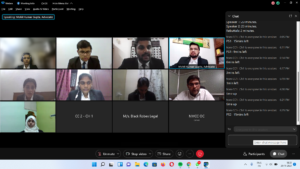
6: 01 PM: Round commences, Petitioner Speaker 1 has commenced arguments for Issue 1.
6:04 PM: Judges question whether the ministers of the government have the right to privacy.
6:07 PM: Judge questions whether Seiji can block the accounts, i.e., is that lawful; what the terms and policy of the SSMI is with regards to blocking on the orders of the government.
6:08 PM: Judge asks if the Speaker has knowledge on the blocking rules of 2009. Whether issuance of notice is invalid or whether the notice by itself is invalid. Whether the petitioners have responded to the notice.
6:11 PM: Whether there is a requirement for the central govt to give notice before blocking information, whether the Petitioners are bringing up the violation of natural justice; The Speaker’s answers have not convinced the court.
6:14 PM: Speaker cites the Donald Trump case.
6: 16 PM: Speaker cites Sec 52, Copyrights Act cited to explain fair use doctrine.
6:18 PM: Judge 1 questions how the work of Balbir Singh be considered literary work, as it is based on research, asks for case law’ Speaker cites Civic Chandran v. Ammini Amma (three pronged test for fair use policy), Judge 1 not satisfied as the facts of the case cited do not have any relation with the instant case.
6:22 PM: Judges question the maintainability of the petition. Speaker 1 has concluded. Speaker 2 has commenced his arguments with due permissions of the court.
6:23 PM: Judge 1 asks if any provisions of the IT rules 2021 have been stayed by any court in the country, and asks for a brief on the cases pending before the courts in this regard, Speaker 2 cites Uday Basu. Speaker pleads ignorance to follow up questions.
6:24 PM: Judge 1 asks the distinction between SMI and SSMI; how many users use Seiji.
6:26 PM: The Counsel cites Shreya Singhal – Hon’ble Justice RF Nariman – “social media intermediary must not be the decision making authority.”
6:28 PM: Judge 1 asks if Seiji is an SSMI or SMI, if not why is Rule 4 being contented. Speaker is unable to answer the questions satisfactorily.
6:29 PM: Judge 1 questions whether Seiji is a news aggregator, and if so why the petitioners are not contending rule 9.
6:32 PM: Petitioner Speaker 2 states that since Seiji does not aggregate, curate or publish its own content, it is not a news or current affairs aggregator.
6:33 PM: Judge 2 asks whether the Petitioners accept the other rules other than Rules 3 to 7, as they are not contending that they are unconstitutional or ultra vires the parent act.
6:36 PM: Speaker is asked to summarize his contentions within 2 minutes.
6:38 PM: Judge 1 asks the issues of the Petitioner against Rule 4; Speaker cites Puttaswamy judgement’s three pronged test.
6:40 PM: Judge 2 asks whether the principles of natural justice were followed with regards to issuance of notice of copyright violation to Dhrithi Tiwari.
6:41 PM: Judge 1 asks the problems with the provisions of the particular rules which violate the principles espoused in the Puttaswamy judgement.
6:44 PM: Judge 1 questions what the problem the rules create to Seiji; asks if Seiji has the ability to break end-to-end encryption; Speaker is unable to answer the questions of the Judges.
6:51 PM: Speaker 2 has concluded his arguments. Respondent Speaker 1 has commenced her submissions with the leave of the court.
6:52 PM: Judge 1 asks how threatened the PM of Nanda is by a single user to block them from all governmental accounts; Speaker 1 says that the PM is not acting in an official capacity.
6:53 PM: Judges ask on what basis the Respondents consider Seiji as a news aggregator, as the Speaker claimed that Seiji is not used for official purposes; Speaker is unable to answer the questions of the judges.
6:55 PM: Knight First Amendment Institute v. Trump cited. Judge 1 asks if the Speaker is aware of the Arvind Kejriwal case. The Speaker pleads ignorance.
7:02 PM: Cites Amish Devgan v. Union of India, Judge 1 asks the symbolism used in the cited case, Speaker is unaware of the case she has cited.
7:05 PM: Judge 1 asks the Speaker what the meaning of a fascist is, whether the issuance of notice is a fascist act. The Counsel cites Submramnayam Swamy v. Union of India to explain the meaning and scope of defamation.
Judge 2 questions whether linguistic division of the State is under the ambit of basic structure of the Constitution; Speaker is unable to answer the questions and pleads ignorance.
7:07 PM: Speaker 1 commences arguments for Issue 2. Cites Otto v. Forced Publications, State of Tamil Nadu v. A N Parashuraman.
7:10 PM: Judge 1 asks the Speaker if she agrees with the statement of the PM (Little girl..), asks her to justify; asks whether the statement of the PM in the public domain is more or less detrimental to the nation.
7:12 PM: Judge 2 asks why the PM has used government resources to put forth his personal views.
7:13 PM: The Speaker cites the case of Campbell v. Reisch Representative.
7:15 PM: Respondent Speaker 2 commences arguments for Issue 3.
7:28 PM: Judge 1 asks for current case laws where the rules have been challenged; whether any stay has been granted; Speaker states that Rule 9(1) and (3) has been stayed.
7:30 PM: Cites Quin Digital Case; answers questions confidently.
7:31 PM: Speaker commences submissions for Issue 4.
7:35 PM: Judge 2 questions the distinction between public and official accounts. Speaker unable to answer the questions of the Court.
7:38 PM: Judge 1 asks the definition of similar intermediaries; what the Respondent characterizes as similar intermediaries; whether Twitter is a news aggregator like Seiji.
7:40 PM: Judge 2 Questions “If the SSMI has to self identify as a news aggregator, what is the procedure? “ The Speaker has answered confidently.
7:41 PM: Question- Where the instant notice would be challenged outside the ambit of the prop, whether a full bench would preside over the matter; Speaker has given an average answer.
7:45 PM: Rebuttals have begun.
7:54 PM: Court Adjourned
Court Hall 2:
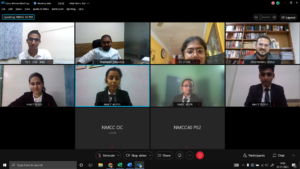
6:06 PM: Counsel 1 from petitioner seeks permission to approach the bench as well as to present the compendium
6:09 PM: The speaker from the petitioner’s side gives a summaries of facts of case. The judge questions the counsel on the jurisdiction of the Court and the nature of contentions.
6:11 PM: The judge questions on whether there is any alternative remedy apart from Article 226 in this case.The counsel answers that they have come under appeal.
6:12 PM: Counsel 1 from petitioners side advances arguments for issue 1.The counsel states that constructive criticism is vital and backs it up with the case of Maneka Gandhi v. Union of India. The counsel states that every citizen must be able to take part in the democratic process.
6:16 PM: Judge questions the counsel on Article 226 and the kind of writs under the same.The counsel reads Article 226 of the Constitution and names the 5 writs.
6:17 PM: The judge asks the counsel to give examples of “other things” under Article 226,the counsel pleads ignorance of the same.Further the counsel briefly states the facts of the Kedarnath case.
6:18 PM: The counsel argues that right to information is a fundamental right under Art.19 and Indu’s right has been violated.
6:19 PM: The judges question the counsel on “reasonable restrictions” under Article 19. The counsel states that information which threatens the sovereignty and integrity of the nation is a reasonable restriction.
6:22 PM: The judges question whether criticism is a reasonable restriction under Art 19. Counsel highlights para 6 of the moot proposition to show what “source of information” means.
6:24 PM: The judge asks the counsel about the year of independence of the United States of America and whether the USA was a commonwealth or not.
6:25 PM: Due to the paucity of the time, counsel 1 finishes arguments for issue 3. The Counsel states that the IT rules are ultra vires and beyond the parent act.The counsel also refers to the case of Shreya Singhal.
6:30 PM: Counsel 1 concludes and Counsel 2 seeks permission to approach the bench.
6:32 PM: The judge questions the counsel on what basis the petitioners have come to the Court.The counsel answers Accordingly.
6:33 PM: The counsel answers the question of Article 74 of the Constitution which describes the need for a Prime Minister.
6:35 PM: The judge requests the counsel to elaborate on the fair use policy.
6:37 PM: The judge questions the basis of copyright infringement with reference to the actions of Drithi Tiwari.
6:40 PM: The judge questions the counsel on the commentary and video share by their client.The counsel moves to Issue 4 and deals with it on two contentions.
6:42 PM: The judge asks whether Seiji moderates content on its platform. The counsel answers by taking help of para 3 of the moot proposition.
6:43 PM: The judge asks whether Seiji moderates content on its platform.The counsel answers by taking help of para 3 of the moot proposition. The counsel is questioned on who a “news aggregator” is.
6:49 PM: The judges asks whether there is a question of law in the notice and why this issue is being brought to court. The counsel explains safe harbor policy under Section 79 of the IT Act of 2000.
6:52 PM: The counsel on behalf of the petitioners humbly submits their prayer.
6:53 PM: The counsel on behalf of the respondents seeks permission to approach the bench and begins with issue 1.
6:56 PM: The judge questions whether the India Penal Code is enough to deal with acts on these platforms.
6:59 PM: The judge questions the rule number which states that social media intermediaries require human intervention.The counsel answers accordingly.
7:02 PM: The counsel is questioned on Section 69(a) of the IT Act.The counsel states that the Union of India wants to protect the sovereignty and integrity of India.
7:14 PM: Speaker 2 from the respondents describes how Indu has turned the public against the government.
7:15PM: The judge questions whether there has been violence after Indu’s tweets. The counsel states that Indu’s tweets were provoking the public to revolt.
7:17 PM: The judge clarifies whether the counsel is representing the party or the Union.He further adds that a conversation between a party and an individual is private and does not concern the union.
7:24 PM: The judge states that the PM’s statement was extremely patriarchal in nature and does not respect the youth.The judge further questions the kinds of criticism.
7:33 PM:The counsel states that if the statements are reasonable, then it does not incite violence. The counsel proceeds to issue 4.
7:36 PM: The judge questions the procedure of appeal.The counsel on behalf of the petitioners brings in the rebuttals. The counsel on behalf of the respondents brings sur-rebuttals.
7:44 PM: The court is adjourned
Court Hall 3:
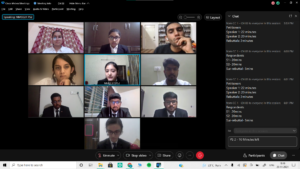
6:02 PM: The petitioners have started the proceeding with the permission of the judges.
6:06 PM:Petitioner Speaker 2 has taken over from Petitioner Speaker1 due to connectivity issues- as directed by the judges.
6:10 PM: Judges have interrupted Petitioner Speaker 2 and have raised questions regarding the clarity of the arguments.
6:30 PM: Petitioner Speaker 1 has restarted her arguments with the permission of the judges.
6:35 PM: Judges have raised questions regarding the validity of the arguments of Petitioner Speaker 1 and have asked for further clarifications.
6:40 PM: Further questions regarding the issues and the laws pertaining to it have been asked by the judges.
6:48 PM: The petitioners have concluded their arguments and have moved to the prayer with the permission of the judges.
6:50 PM:The Respondents have started with their arguments with the permission of the judges.
6:54 PM:The Respondents have put forth the compendium which indicates twitter privacy policy, the IT intermediary guidelines, FCRA Act, the Copyrights Rules, 1957.
6:56 PM:The judges have raised the scope of Article 12 with respect to this case. Judges have pointed out instances where the court has put forward a counter view to the arguments of the Respondent speaker 1.
7:00 PM: The judges have asked for the precedence value of the arguments raised by the Speaker.
7:03 PM: Respondent Speaker 1 has drawn the attention of the judges to page 9 of FCRA Act mentioned in the compendium.
7:06 PM: Judges ask the Respondent Speaker 1 as to what basis foreign contribution can be defined.
7:09 PM: Paragraph 68 of the FCRA Act has been referred to by the Respondent Speaker 1.
7:11 PM:The council has raised Section 57 of the Copyrights Act that it is exhaustive in nature and can’t be compared to its US counterpart.
7:17 PM: Respondent Speaker 2 argued that the fundamental rights are not absolute in nature and thus can’t be applicable to all situations.
7:21 PM:Paragraph 47 of the compendium has been referred to by Respondent Speaker 2.
7:22 PM: The rule of proportionality has been reviewed with respect to this case by the Respondent Speaker 2. The judge poses questions as to how the line has been drawn between the Law and the business with respect to this case.
7:29 PM: The respondents have concluded with arguments and have moved to the prayer.
7:31 PM: The petitioners have started with the rebuttal.
7:34 PM: The Respondents have started their sur-rebuttal.
7:38 PM: Court Hall is adjourned.
Court Hall 4:
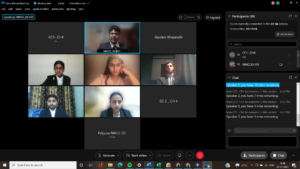
6:02 PM: The Judges have joined the Court Hall and the round has commenced.
6:04 PM: Petitioner Speaker 1 approaches the bench and with the permission of the judges begins with issue 1.
6:06 PM: Speaker 1 opines how public criticism of the governmental authorities is essential for a good governance. Further, the Counsel cites the case of Shreya Singhal v. Union of India.
6:09 PM: Petitioner speaker 1 talks about how tagging a prime minister on a post has a major impact.
6:10 PM: Judge 2 corrects Petitioner speaker 1 that a particular statement was not stated in the facts and therefore, cannot be assumed in their favour. Petitioner speaker 1 cites the Kedarnath case.
6:12 PM: Petitioner Speaker 1 submits issue 1 and begins with issue 3. Petitioner speaker 1 states the principle 5 of Manila principles of intermediary liability.
Petitioner speaker 1 speaks about Part 2 of the rules having a chilling effect on their freedom of speech and expression.
6:15 PM: Petitioner speaker 1 states the proportionality test. And goes on to speak about rule 4(2) of IT rules.
Judge 2 poses a question that these rules are required for the safety and to prevent misuse of encryption these rules are very necessary.
6:17 PM: Petitioner speaker 1 speaks about the procedural mechanism in support of their answer.
6:19 PM: Judge 1 questions that these rules are for SSI and not every intermediary. Petitioner speaker 1 goes on to define the scope of SSI ( significant social media intermediary)
Petitioner speaker 1 submits their arguments.
6:21 PM: Petitioner speaker 2 begins with the permission of the judges and firstly begins by answering the judge’s questions raised previously.
6:25 PM: Petitioner speaker 2 shares the document of Meity showing the framework for the powers of government authorities to block certain content.
6:27 PM: Petitioner speaker 2 starts with issue 2 and speaks about the Freedom of Speech and Expression. Counsel cites the case of Lange v Australian Corporation and talks about copyright laws.
6:30 PM: Judge 2 poses a question that since Tiwari’s video is relied on in the research paper, how does it not come under fair use policy?
6:32 PM: Petitioner speaker 2 goes on to answer by defining fair use and states the factors to support their argument. The Counsel cites the case of Peter men v RNC (American case).
Petitioner speaker 2 talks about foreign copyright laws.
6:34 PM: Petitioner speaker 2 proceeds to issue 4 and talks about the notice issued to Seiji.
Judge 1 poses the question that just because it is identified as a news aggregator it cannot be the substance, so the speaker was asked to substantiate that point.
6:37 PM: Petitioner speaker 2 states the inconsistency in FDI policy and FCRA policy.
6:39 PM: Petitioner speaker 2 states the inconsistency in FDI policy and FCRA policy.
6:41 PM: Petitioner speaker 2 explains how Seiji is a for profit organization. Petitioner speaker 2 submits the arguments.
6: 45 PM: Respondent speaker 1 begins with the permission of judges. Proceeds with issue 1.
6: 47 PM: Respondent speaker 1 states how the UNP and prime minister does not fall under the ambit of state. The speaker cites R.D Shetty’s case in support of the argument. Respondent speaker 1 cites Zee Telefilm case and talks about public function.
6:49 PM: Judge 2 poses a question on how they are not violating Article 14 as they have an official account. Respondent speaker 1 speaks about the public account of the officials.
6:51 PM: Respondent speaker 1 Cites BCCI case.
Judge 2 poses a question that since the prime minister is a public authority, how can someone block any content?
6:55 PM: Respondent speaker 1 cites Donoghue v Public housing case and says that ministers have no control over private entities.
6:57 PM: Judge 2 poses a question about the doctrine of public accountability and what the respondent has to say about that.
7:00 PM: Respondent speaker 1 proceeds with their last contention and talks about the right to information.
7:02 PM: Respondent speaker 1 begins with the issue 2. Speaker talks about a 4 factor test of the Copyright work.
7:04 PM: Respondent speaker 1 speaks about the Campbell test. Respondent speaker 1 speaks about the RNC case and talks about the political freedom of speech and expression. Judge 2 poses the question that essentially the presentation is different and so how does it constitute infringement of copyright.
7:07 PM: Respondent speaker 1 concludes their arguments.
Respondent speaker 2 begins with the permission of the judges with issue 3 and 4.
7:11 PM: Respondent speaker 2 talks about the notice and the legal procedure of the reply and points out how petitioners have wrongly approached.
7:13 PM: Judge 2 questions how investment falls under contribution and gifts and how it will fall under FCRA.
7:14 PM: Respondent speaker 2 goes on to define investment and contribution to support their argument.
7:16 PM: Judge 1 poses a question about how they claim the investment to be a donation since it is in a private company. Respondent speaker 2 responds by talking about the term securities defined by FCRA.
7:18 PM: Respondent speaker 2 speaks about how the video by Dhrithi Tiwari resulted in a victory of their party in 6 states.
7:20 PM: Respondent speaker 2 speaks about rule 3(g). And goes on to define social media intermediary and news aggregator.
7:21 PM: Respondent speaker 2 seeks permission to move on with issue 3.
7:24 PM: Judge 2 poses the question that these rules are vague and do not have adequate definitions and can be misused.
7:28 PM: Respondent speaker 2 responds by making reference to rule 3 and must be interpreted in light of Article 19. Respondent speaker 2 speaks about rule 4(2) and talks about a three fold test.
7:30 PM: Respondent speaker 2 speaks about how the platform would have to necessarily break end to end encryption and how they share the mets data for identifying the first originator.
7:33 PM: Respondent speaker 2 sums up their submissions.
7:38 PM: Respondent Speaker 2 proceeds with sur-rebuttal.
7:41 PM: The Court Hall has been adjourned.
With this Day 3 comes to an end!
Let us begin with DAY 4!
The Semi-final rounds are scheduled from 11 AM onwards.
10:49 AM: The Judges Briefing Session is in progress.
Meet the judges for the Semi-Final Rounds:
1. Mr. Rajas Pingle, Managing Partner at Net Lawgic Legal which is an Award Winning and highly successful Law Firm that specializes in Cyber Law / Information Technology Law.
2. Mr. Kiron Noronha, Regional Legal Counsel at Enphase Energy, Former Senior Legal Executive- Wipro
3. Mr. Rajeev Rambhatla, Head- Hyderabad at King Stubb & Kasiva, Advocates & Attorneys.
4. Adv. Tony Philip, Head of Legal – Commercial Contracts at Turing.com.
May the best team win!
Court Hall 1:
Judged by Mr. Tony Philip and Mr. Kiron Noronha.
11:06 AM: The counsel on behalf of the petitioner seeks permission to approach the bench. The judge grants permission. The counsel is requested to summarize facts of the case in 1.5 minutes and the speaker does so accordingly.
11:07 AM: After summarizing the facts of the case,speaker 1 seeks permission to begin his arguments for issue 1.The speaker takes the support of the BCCI case to state that a private entity can invoke writ jurisdiction.
11:09 AM: The counsel states that the Government and its officials use Seiji to communicate to the public and such accounts have accountability to the public.
11:10 AM: The judge asks the speaker if they are splitting the public as well as personal accounts of the Prime Ministers and the counsel answers accordingly.
11:11 AM: The judge questions the relation between the number of following to the accountability and whether it is directly proportional.The counsel answers the same.
11:13 AM: The counsel states that both the public as well as private accounts of the ministers come under the “public law function”.The judge questions the speaker on why Seiji is questioned here although there are other modes of dissemination of information.
11:14 AM: The counsel highlights the moot proposition to state that government policies are put on these social medias by the ministers,thus bringing in the aspect of government accountability and their mode of engaging with its citizens.
11:15 AM: The counsel highlights the test of ”public law function”.
11:17 AM: The concept of designated public forum is explained by the counsel with reference to the case of Buckingham v. State of California. Further Landmark case of Committee of Canada v. Canada was stated to describe a public forum. The counsel states that the act of blocking equals to not being able to voice out one’s own opinions.
11:19 AM: The judge questions whether Indu still has tagging rights on the platform. The counsel states that Indu has used emojis and stated that the PM will ruin the diversity of India.
11:20 AM: The counsel states that the “insults” against the PM are not “seditious in nature” and no offence of defamation has been committed.
11:21 AM: The judge asks the counsel to differentiate between defamation and sedition and asks the speaker to state the “reasonable restrictions” under freedom of speech and expression.
11:23 AM: The counsel highlights the algorithm of Seiji and states that it is not a case of defamation as the government is a “public functionary”. Mere criticism does not mean it is a case of defamation.
Government organizations are including these platforms to disseminate and engage with the public and therefore,blocking Indu is arbitrary in nature. The counsel further elaborates on why Indu’s speech should be protected.
11:25 AM: The counsel states that in the case of Davidson v. Randal in the American Courts,the facts of the case were similar and the court held that the freedom of speech and expression should be protected.On further note R.G Anand v. Deluxe Films was taken as an example in arguments for Issue 2.
11:28 AM: The judge questions the counsel on Drithi Tiwari and states that a right wing party is in power and is generally against left wing ideologies.The judge questions that there was no commercial benefit and the counsel begs to differ.
11:30 AM: The counsel requests for a 30 second extension to conclude his arguments. He states that there is no reduction in competition for Balvir Singh.
11:32 AM: Speaker 2 seeks permission to approach the Bench and begin his arguments. Permission has been granted. The counsel Rule 3(1)(b) violates Art 14 as well as 19 of the Constitution.
11:33 AM: Director v.Collon Case– The counsel uses this commonwealth case to state that the meaning of the word “obscene” is vague and subject to interpretation.
The counsel furthers highlights the case of Shreya SInghal v. UOI to support his arguments.
11:34 AM: The following case Kartar Singh v. State of Punjab-even if a single term is subject to interpretation,the court can strike down the legislation.This was taken as an example.
11:36 AM: The judge questions why an entire section or Act should be taken down if a few terms are subjective and vague. He further states that this affects the doctrine of severability.
11:37 AM: Section 79 of the Shreya Singhal case, to define the safe harbour principle, is brought in to support the violation of rights.
11:39 AM: The counsel states that in case there is no removal within 24 hours,the platform would be subject to punishment under rule 7 which violates the safe harbour principle.
11:40 AM: The counsel states that there is a self regulating principle in place by social media platforms.
11:43 AM: The judge questions whether Seiji is a social media intermediary under Section 4 of the Act.The counsel states that the moot proposition is silent on the number of users on Seiji.
11:46 AM: The counsel moves onto issue 4 and speaks about rule 4 sub-rule 2 which mandates traceability of the first originator and provides the example of the Puttaswamy case.The counsel furthers states that nothing in the parent act enforces on the social media intermediaries to trace the first originator.
11:49 AM: The counsel further highlights that the “end to end encryption” will be broken if the first originator has to be identified.
11:52 AM: The counsel states that only minimum amount of data can be edited by the social media intermediaries and there is no presence of a a personal data bill in the land.
11:53 AM: The counsel seeks two more minutes to finish issue 4 and defines” news aggregator” and states that Seiji is not one.
11:54 AM: The judge questions the speaker on examples of news aggregators in the Union of Nanda. The counsel gives the example of Quint which determines what information is put on their platforms
11:57 AM: The counsel argues that there is no political bias as there is no human intervention in the platform of Seiji. The speaker humbly submits his prayer before the court on behalf of the petitioner.
11:58 AM: Counsel on behalf of the respondents seeks permission to address the bench. The counsel highlights para 9 of the moot proposition to state that Indu incited violence,thereby derailing public order.
12:02 PM: The judges question the counsel on the right to protest under Article 19 of the Constitution. The judges state that streets are historically meant for protest and hence does not agree with the counsel. The judges ask the counsel to read out the post which caused public violence.
12:04 PM: The counsel highlights the fact in the moot proposition to state that Indu committed these acts to gain popularity.
12:06 PM: The counsel referred to para 11 of the proposition to state that after Indu was blocked by ministers,her popularity diminished.The counsel highlights these train of facts to prove her intention to gain popularity.
12:09 PM: The judge further questions that Indu,as a member of a participative democracy,has a right to express opinions on a public forum.The judge questions that Samar Pratap’s activism has not been curtailed rather Indu’s has.
The counsel argues that the “reasonable restrictions” under Art 19. states that public protection is vital.
12:11 PM: The judges further questions on the violation of Indu’s right to information.
12:13 PM: The judge questions the PM’s statement which personally attacks a citizen’s freedom of speech and expression.The judge questions the counsel of the ground of the government for the same.The counsel states that Indu provoked herself to go to the streets.
12:15 PM: The judge states that the PM’s statement calling Indu a “little girl” is unparliamentary.
12:16 PM: The judge further questions the counsel on the ingredients of sedition.The counsel explains accordingly.
12:20 PM: The counsel summarizes issue 2 by stating that rule 3(1)(b) is both constitutional and lawful and the government can strike down. The counsel discusses rule 4 sub rule 2 and concludes that rule 3-7 is completely constitutional.
12:22 PM: The speaker 2 seeks permission to approach the bench and present the compendium.
12:23 PM: The speaker elaborates on Section 17 of the Copyright Act and explains to 2 fold test stating that the subsequent work should be different from the original.
12:28 PM: The counsel elaborates on the case of D.C. Tiwari. The counsel states that since the work is different,there is a fair use of content under Section 52.
12:31 PM: The judge questions the counsel on the proviso under Section 52 of the Copyright Act which allows the owner to file a complaint.
12:32 PM: The counsel proceeds to issue 4.The first submission deals with the notice issued. Seiji is said to be a news aggregator and hence there can be no foreign funding.
The judge asks the counsel to read the section which prohibits foreign funding.The counsel does so accordingly.
12:36 PM: The judge asks the difference between foreign investment and funding under Nanda’s FDI policy.
12:37 PM: The counsel states that Seiji is a big online platform. The judge asks how the FCRA applies to Seiji.
12:40 PM: The counsel states that Seiji is not a news aggregator and states that change in algorithm is completely in the hands of the social media platform.
12:45 PM: The judge questions on foreign influence and the FDI policy of Nanda which is seen as arbitrary.
12:47 PM: The judge questions the counsel on Section 11 of FCRA Act,i.e terms such as cultural and social act.The counsel acts accordingly.
12:51 PM: The counsel of behalf of respondents humbly submits their prayer.
Counsel on behalf of petitioners begins their rebuttals for 2 minutes, highlighting the case of Balvant Singh v. State of Punjab.
12:53 PM: The counsel on behalf of respondents begin their sur-rebutal for a course of 2 minutes.
12:59 PM: The Rounds have come to an end. The Court Hall has been adjourned.
Court Hall 2:
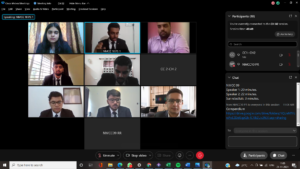
Judges: Mr. Rajeev Rambhatla and Mr. Rajas Pingle.
11:03 AM: Both the Judges have joined the meeting and petitioner 1 has started with the issues 1 and 2.
11.08 AM: The doctrine of public accountability was brought up to show how the statements blocked by the Government officials were unlawful.
11.10 AM: Petitioner 1 elaborates on why the Government officials’ post provides discourse and public opinion on the account and the post and hence, Indu cannot be restricted from accessing the public forum. There was a claim that the right of Indu under Art 14 was being violated by the government by blocking her account.
11.14 AM:The Fundamental right to receive information in the best possible way was violated as mentioned in citation 40 of the petitioner’s memorial which elaborates on how restriction of her account removes her right to reply.
11.16 AM: Petitioner 1 moves on to conclude by claiming that the process of the government officials was unlawful in nature. Petitioner 1 now moves on to issue D of the proposition. Section 3 of the foreign contribution Act was brought up in relation to section 210 of the IT Act.
11.18 AM: The topic of a news aggregator was brought up by Petitioner 1 to show that Seiji is not providing any foreign contribution. Rule 3 of the Foreign Contribution Guidelines were brought up to show how any organization is political in nature if it fits the criteria.
11.24 AM: Twitter’s policy in regards to political content was brought up to how Twitter doesn’t promote any form of Political ads or discourse as compared to Seiji and its policies which don’t endorse any political content. Judge questions Petitioner 1 on his comparison of Seiji and Twitter on the lines of how they both restrict users from posting political ads. Petitioner 1 answers confidently and explains that if any political entity approaches Seiji for posting any political content, Seiji will not endorse the same as it goes against their business model.
11.26 AM: Petitioner 2 goes ahead with issue 3 to explain the use of Fair use and Fair dealing and how it was carved out from international copyright laws. Bernie conventions and Article 13 of the TRIPS agreement was brought up by Petitioner 2. Section 107 of the copyright act 1957 was also brought up by the Petitioner to show how enhancing information can be compared to the 3 fold test.
11.30 AM: Blackwood Sons v A N Parasuram was cited by Petitioner 1 and the researcher was asked to present the facts of the given case to show the mode of expression is the most important aspect of adaptation in regards to a movie or video. Research paper is an academic tool which cannot be changed into a video and hence there was a claim that there was no real copying of content taking place.
11.34 AM: Petitioner 2 goes on to Issue 3 of the proposition and elaborates on how the Section 21w of the IT Act 2000 which classifies intermediaries into SSMIs and SMIs and its applicability to due diligence on the same.
11.39 AM: Second leg of the argument was brought up to show how rule 307 of the IT act violates the right of Article 21 which a person holds. K S Puttaswamy case was cited to show how the three fold test was used to prove legality, necessity and proportionality.
11.42 AM: Shreya Singhal v Union of India was cited to show how Free speech was violated and restricted in the following instance. Rule 31 c and 31b of the IT Act was also brought up to show how there exists a compromise of the petitioners freedom of speech.
11.46 AM: Petitioner 2 moved on to the prayer of the petitioner’s side.
11.47 AM:Respondent 1 with the permission of the judge moved on to elaborate on the facts of the case to which the judges replied that they are aware of the facts of the case.
11.50 AM: Accounts of the Government authorities were claimed to not be public forums and thus blocking of Indus accounts was lawful in nature. Article 12 which defines ‘State forums’ was brought up that financial assistance of the State doesn’t mean that these online forums aren’t an extension of the State. All Govt officials accounts act as a regular account as that of a regular citizen of the country.
11.57 AM: The difference between a public forum and a social media platform was brought up to prove that Govt authorities and officials do not count as a public forum. Judge moved on to question Respondent 1 on the same to prove how an official Govt authorized account doesn’t act as a public forum for comments and discourse. Respondent 1 moved on to explain that the blocking of Indu’s account was lawful in nature as her hateful comment and use of her account goes against the rules of the social media platform.
12.02 PM: Respondent 1 moves into his second contention to prove that the video of the sharing of the research paper acts as a copyright infringement notice. The doctrine of fair use was said to be infringed and section 52 of the act doesn’t not normally allow reproduction of any original work. Civic Chandra v Amini Amma was a case that was cited by respondent 1 to which he was questioned on the facts of the case.
12.07 PM: Respondent 1 moves on to conclude on his issues and that the district ruling should be upheld by the court
12.09 PM: Respondent 2 moves on to provide his arguments on Issues 3 and 4 of the proposition. Poonawala v Union of India was cited by Respondent 2 along Prajwala V Union of India to show how the parent IT act has aspects that are unconstitutional in nature.
12.15 PM: Section 17 of the IT Act 2000 was brought up to show how due diligence is always required to ensure that the terms of these social media platforms are not ambiguous in nature. Right to privacy in relation to its connection to the public must be considered while citing the K S Puttaswamy case. Proportionality was another factor of the 3 fold test that was brought up by respondents to show how the right to privacy is not an absolute right. The case of Facebook v Union of India was further cited to show how the intermediaries are the ones who need to ensure due diligence.
12.22 PM: Section 5 of the Foreign Contribution Act was cited by respondent 2 to elaborate on the topic of Seiji not being a news aggregator. Respondent 1 ends with the contentions of their arguments and claims that both the IT rules and section 307 do not only apply to social media intermediaries.
12.25 PM: Respondent 2 moves on to the prayer of the respondents side and moves on to conclude with their arguments.
12.26 PM: Petitioner 1 moves on to providing their side’s rebuttals for a span of 5 minutes. The substantive rebuttals were brought up to show how the test of substantiality is the most important test while looking at whether Seiji can be constituted under article 12 of the parent act. Data retention was brought up to show how both Nanda and India do not have any data protection processes that are fully established.
12.30 PM: Respondent 1 moves into providing the respondents side of sur-rebuttal.
12:33 PM: The session has been concluded and the Court Hall has been adjourned.
With this, the Semi-Final Rounds of 12th National Moot Court Competition 2021 comes to an end.
The two best teams will now argue before the decorated quorum of Judges at 4:00 PM today.
STAY TUNED FOR MORE UPDATES!
The Moot Court Society is proud to host the Final Round and Valedictory Ceremony of the 12th edition of National Moot Court Competition 2021on 21st November 2021 (Sunday) via the Cisco WebEx Platform.
- Hon’ble Mr. Justice N. Anand Venkatesh – Judge, High Court of Madras
- Hon’ble Mr. Justice R Natraj – Judge, High Court of Karnataka
4:03 PM: Both the judges have joined the meet.
4:15 PM: Commencement of scoring briefing and itinerary briefing to the Bench.
4:20 PM: Commencement of proposition briefing to the Bench.
4:26 PM: The rounds commence. The judges are introduced to the audience by the MC Mr Shashank Bharadwaj.
4:30 PM: Petitioner Speaker 1 commences his arguments with the permission of the Bench.
4:31 PM: Petitioner Speaker 1 commences briefing the facts to the Bench.
4:33 PM: Petitioner Speaker 1 begins arguments for Issue 1 with due permission from the Bench.
4:35 PM: The Speaker cites Article 12 of the Constitution to define and explain the meaning of ‘entity’.
4:36 PM: Speaker argues that the social media accounts of the government authorities fall under the ambit of the State according to Article 12.
4:38 PM: Hon’ble Justice Natraj questions the reason and justification behind blocking of Indu; who gets access to the information. Petitioner Speaker 1 answers confidently.
4:40 PM: Petitioner Speaker 1 begins submissions for Issue 2.
4:41 PM: Petitioner Speaker 1 argues that the work of Dhriti Tiwari falls under the ambit of literary work – Sec 52 of Copyright Act and cites Civic Chandra v. Ammini Amma, to explain the three prong test for the Fail Use Policy.
4:43 PM: Petitioner Speaker 1 concludes his arguments. Hon’ble Justice Nataraj questions how the causes of actions of Indu and Tiwari have been clubbed to which the speaker responds confidently.
4:45 PM: Petitioner Speaker 2 starts his submissions for Issue 2. He talks about whether Rules 3 to 7 are unconstitutional, cites Shreya Singhal v. Union of India and mentions Justice RF Nariman’s judgement that intermediaries must not be put in the role of a judge.
4:50 PM: Petitioner Speaker 2 cites K.S. Puttaswamy v. Union of India relating to violation of right to privacy by breaking end-to-end encryption.
4:52 PM: Petitioner Speaker 2 argues that IT Rules. 2021 are violative of Article 14 as they do not fall under the scope of the reasonable restrictions. He further cites T M Krishna WP challenging the vagueness, arbitrariness of the Rules.
4:56 PM: Petitioner Speaker 2 commences arguments for Issue 4 with respect to the notice issued by the Government to Seiji.
4:58 PM: Petitioner Speaker 2 argues that Seiji is not a news aggregator as Seiji does not curate or publish its own content, it is merely a platform for the users to put forth their content.
4:59 PM: Petitioner Speaker 2 concludes his arguments and commences the pleading of prayers.
5:02 PM: Respondent Speaker 1 commences his arguments with the leave of the Court.
5:03 PM: Respondent Speaker 1 begins her submissions for Issue 1 and cites R. D. Shetty v. International Airport Authority.
5:07 PM: Respondent Speaker 1 argues that the act of blocking is not a State action as Seiji has its own jurisdiction on the matter.
5:09 PM: Hon’ble Justice Natraj questions respondent speaker 1 that if all the information of the government rested on Seiji then doesn’t blocking Indu from the platform, violating her right to information under Art 21. The speaker responds confidently.
5:13 PM: Respondent Speaker 1 commences submissions for Issue 2 by citing Campbell v. Mirror Group Newspapers Ltd. and R. G. Anand v. Delux Film.
5:16 PM: Respondent Speaker 2 cites Rupendra Kashyap v. Jiwan Publishing House to argue that there is a copyright infringement in the video.
5:18 PM: Respondent Speaker 1 concludes his arguments.
5:19 PM: Respondent Speaker 2 starts his submissions for Issue 3 and cites Shreya Singhal v. Union of India. He argues that terms such as “defamation, racial, discrimination based on gender, etc.” have been defined in various other legislations therefore, they are not vague.
5:22 PM: Respondent Speaker 2 cites Santosh Singh v. Delhi Administration which talks about the Test of Reasonableness that relies on three factors; Rules 3 and 5 are merely laying down a regulatory mechanism, therefore, they are reasonable as per the three prong test espoused in this judgement.
5:25 PM: Respondent Speaker 2 cites K.S. Puttaswamy v. Union of India, for the three-prong test of proportionality and also cites the India Social Action case to assert the powers of the Government as per the IT Act, 2000.
5:27 PM: Hon’ble Justice Anand Venkatesh questions whether Indu’s request to Seiji to remove the PM’s account was defamatory. Speaker answers confidently.
5:29 PM: Respondent Speaker 2 commences his arguments for Issue 4.
5:32 PM: Respondent Speaker 2’s time has elapsed. With the leave of the court, the time has been extended by 2 minutes.
5:35 PM: Respondent Speaker 2 concludes his arguments and proceeds to plead for prayers.
5:38 PM: The rounds have come to an end. The court is adjourned. Scoring has begun, the Bench will take a consensual decision.
The Valedictory Session has begun.
5:43 PM: The Valedictory Ceremony commences. MC Mr Shashank Bharadwaj begins by welcoming the esteemed dignitaries.
5:46 PM: Dr Jayadevan S Nair, Dean, School of Law, CHRIST (Deemed to be) University, commences his address. He introduces the dignitaries who have graced the occasion- Chief Guest Hon’ble Mr. Justice Abdul Nazeer, Judge, Supreme Court of India, Guest of Honor Hon’ble Mr. Justice N. Anand Venkatesh, Judge, High Court of Madras, Guest of Honor, Hon’ble Mr. Justice R Natraj, Judge, High Court of Karnataka and the Guest of Honor, Adv. Mathew Chacko, Partner, Spice Route Legal.
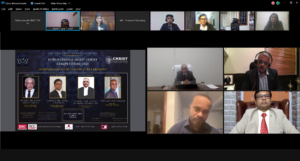
5:55 PM: The invocation and lighting of the lamp ceremony commences to mark this auspicious occasion.
5:57 PM: Commencement of the Chief Guest address by Hon’ble Justice Abdul Nazeer.
6:00 PM: Hon’ble Mr. Justice Abdul Nazeer talks in depth about IT Rules and its relevance in the current times. He further states that “Healthy Competition between law students is a commendable way to learn law.”
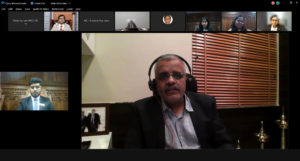
6:17 PM: Address of Hon’ble Justice R Natraj has commenced. He opines and addresses people who want to take up law as a profession, and urges to them to explore all their options as there are plenty of opportunities to thrive. According to him, the real challenge would be when one is capable of wiping the tears of those who are really in need justice. He also asks aspiring lawyers to take up human cause first. He concludes by asking young aspiring lawyers to take up law with the vigor that it needs.
6:23 PM: Commencement of address by Hon’ble Justice Anand Venkatesh. Your Lordship believes that the virtual mode is here to remain even when things return to normal. He congratulates the participants on their research and the vigor with which they answered the questions. He reiterates that participation is more important than winning as it helps in the overall development.
He further urges to “Bring the cyberspace under our control” and states that unless it is done, a lot of recklessness and violence will be there as there will be no institutions that would be able to control the way people use cyberspace to express themselves. Lordship concludes by saying the Judiciary is not for the rich, not the influential, not the industrialists but for the last citizen. Judiciary is the hope for those who come knocking at the doors of the judiciary.
6:35 PM: Commencement of address by Adv. Mathew Chacko, Partner, Spice Route Legal.
6:42 PM: Video presentation of the journey of the 12th National Moot Court Competition, 2021.
6:46 PM: Rev. Fr. Benny Thomas addresses the gathering and announces the results:
Best Speaker: Ms. Aishwarya Patney, Army Institute of Law, Mohali
Best Researcher: Ms. Shria Seth, Jindal Global Law School
Best Memorial: Mr. Abhishek Nair, Mr. Aditya Pratap Singh and Ms. Kinjal Keya, Chanakya National Law University
Runners-Up: Mr. Aditya Srivastava, Mr. Devanshu Mehra and Ms. Shereen Moza, Rajiv Gandhi National University of Law
Winners: Mr. Abhishek Nair, Mr. Aditya Pratap Singh and Ms. Kinjal Keya, Chanakya National Law University.
6:50 PM: Ms. Akshaya, Core Committee Member, Moot court Society, School of Law, CHRIST (Deemed to be) University, gives the event report.
6:54 PM: Ms. Rachna Dubey, Convener, Moot court Society, School of Law, CHRIST (Deemed to be) University renders the vote of thanks.


